Article Review Generator
Here is your article critique :
Writing an article review can become a daunting task for any student. It requires analyzing the article's content, evaluating it, and sharing personal insights. Stuck with summarizing the article rather than criticizing it? Use this article review generator!
- ️🎤 What Is This Review Generator?
- ️👑 Article Review Generator Benefits
- ️🤔 When to Use the Tool
- ️✍️ How to Write an Article Review
- ️❓ Article Review Generator Free: FAQ
- ️🔗 References

🎤 What Is the Article Review Generator?
Our online article review generator is an excellent solution for crafting comprehensive reviews. It offers in-depth analysis while ensuring that the main ideas from the article are effectively highlighted. The tool allows students to focus on critical evaluation and personal insights rather than getting bogged down in summarization.
An article review is a piece that critically evaluates and analyzes a scholarly article or research paper. It involves summarizing the article's main points, assessing its strengths and weaknesses, and providing personal opinion.
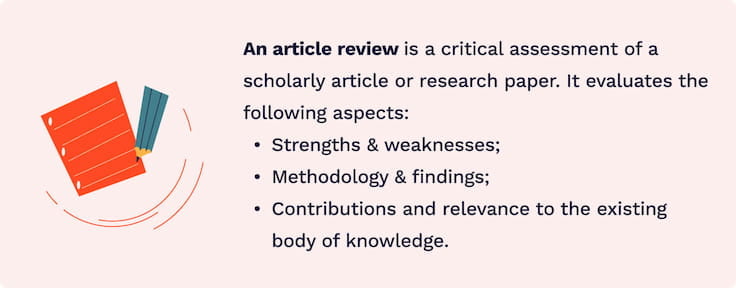
You may need to write an article analysis:
- To provide a critique of a specific article or paper.
- To contribute to academic discourse by evaluating scholarly work.
- To improve your writing skills via summarizing, analyzing, and critiquing complex texts.
- To deepen understanding of a topic.
- To prepare for future research projects.
👑 Online Article Review Generator: 6 Benefits
Many benefits make our article review summary generator stand out. For example, it is:
🤔 When to Use the Article Reviewer Tool?
Our tool is not only helpful in writing article reviews, but it also comes in handy for a variety of other purposes. Here are some cases when you can use the article review summary generator:
- Analyze the article's strengths and weaknesses.
- Quickly understand the key points and arguments of the article.
- Get a new perspective on the article's content and structure.
- Generate a concise summary of an article.
- Understand complex articles more effectively.
- Improve writing skills .
- Be informed about current developments.
- Prepare for exams or presentations.
- Facilitate collaboration during group projects.
- Get multiple article summaries for the literature review.
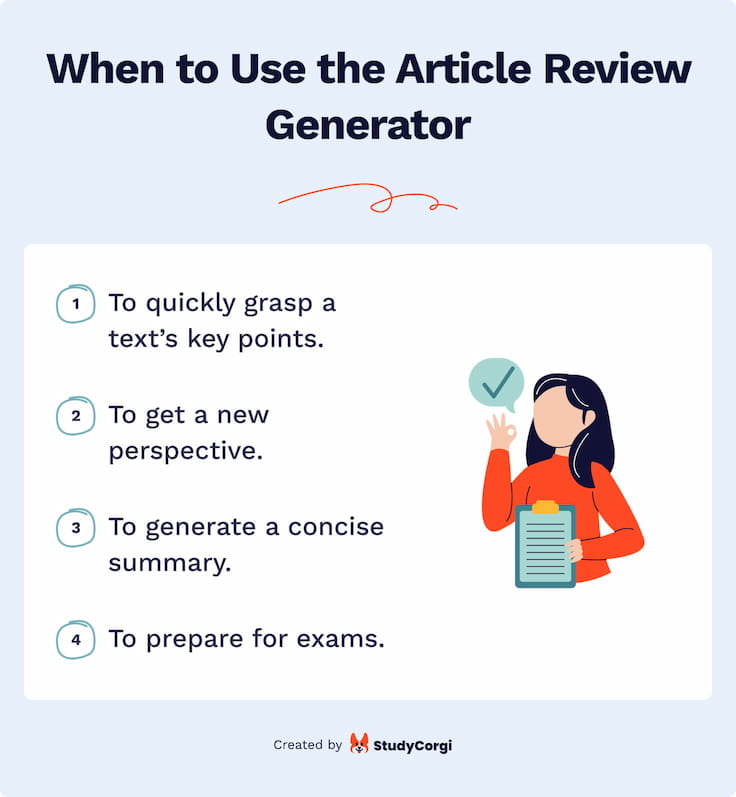
✍️ How to Write an Article Review
You can always use our online article review generator to analyze and evaluate an article quickly. However, if you have time and want to enhance your academic writing skills, you might want to consider writing the review yourself. To help you with this, we've prepared a step-by-step guide for crafting a comprehensive article review .
Step 1 – Preparation
You should clearly understand the task's purpose to prepare for an article review. An article review is more than just a summary or sharing your personal opinion ; it involves a critical analysis and evaluation of the content.
Here are some crucial steps that will help you be fully prepared for writing an article review:
- Assess the title. Before delving into the article, consider what the title suggests about the content and the potential focus of the author's argument.
- Analyze the structure. Subheadings can offer a roadmap of the article's structure and organization. Focus on them to get an overview of the key topics and themes that the author will address.
- Understand the main idea. Identify the central argument or thesis of the article. This is the primary claim or position that the author is asserting.
- Analyze the abstract. The abstract provides a condensed summary of the entire article, offering a glimpse into the main arguments, research methodology, and conclusions.
Step 2 – Reading
Correctly reading an article is essential for making a well-informed evaluation , so don't underestimate this step. Take notes or use highlighters to keep track of the information you might refer to later. We recommend paying attention to:
- Intended audience . Determine who the article is addressing. Consider the level of expertise, interests, and background knowledge the author assumes about the readers.
- Author's purpose. Is the author aiming to summarize existing research, present a new argument, or refute others' claims?
- Key terms. Note whether the author defines key terms or concepts. A clear definition of terms helps in understanding the author's arguments effectively.
- Facts and opinions. Differentiate between factual information and the author's views. Assess the reliability and validity of the information presented.
- Central arguments and conclusions. Assess their clarity, coherence, and the extent to which they are supported by evidence and analysis.
- Methodology and results. Examine the methods and expected results in the article. Assess the credibility of the research and the reported findings' clarity.
- Visual aids. If the article includes illustrations or charts, assess their effectiveness in conveying information and supporting the content.
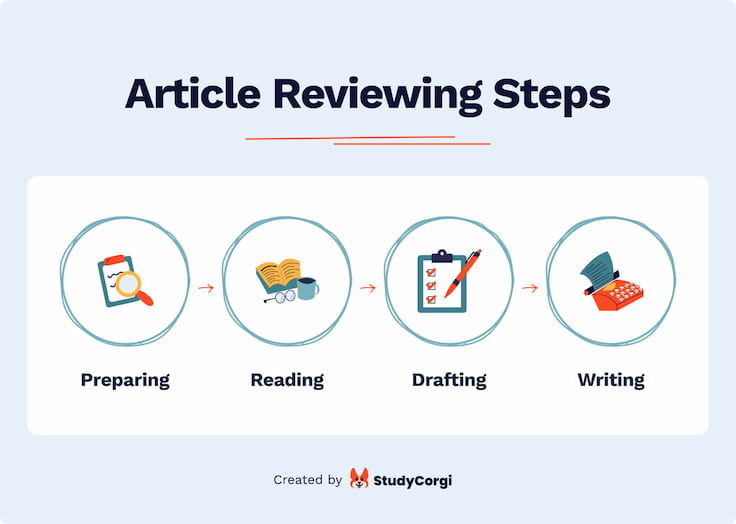
Step 3 – Outlining & Drafting
Creating an outline for an article review can help you organize your ideas and guarantee that your review is well-structured and coherent. Usually, the outline includes an introduction, the body of the review, and a conclusion.
When writing an outline, work on your thesis statement . A thesis statement is a sentence or two that presents the main argument you are making about the article. It is the central point that you will support and develop throughout your review.
After finishing your outline, you can move on to writing a draft. These are the main components for each section of an article review:
- Hook (attention-grabbing opening).
- Background information on the article.
- Thesis statement.
- Summary of the article.
- Analysis and evaluation.
- Restated thesis statement.
- Summary of your main points.
- Final evaluation of the article.
- Suggestions for further research or areas for improvement.
Step 4 – Writing
The final stage of writing an article critique involves reviewing and polishing the draft. It is important to revise the piece and check for any mistakes or inconsistencies. Additionally, we recommend double-checking all citations and references and ensuring they are carefully formatted according to the requirements provided in the assignment.
During the review and polishing process, consider the following:
- Review title. Consider creating a suitable title for the article review if a title is not provided. A good article review title should convey the text's main focus, include keywords, and hint at what readers can expect from the review.
- Reference list. Include a reference list to acknowledge and give credit to the sources you have used in your review. Even if the review only references the article being analyzed, the reference list should include this article.
❓ Article Review Generator Free: FAQ
❓ what is an article review.
An article review critically evaluates and analyzes a scholarly article or research paper. It summarizes the main points, critiques the methodology, and discusses the significance and potential limitations of the work. Article reviews are a common assignment among high school and college students.
❓ How to write an article review?
Writing an article review starts with thorough preparation and understanding of the article's context. Then, carefully read the article to identify critical points and evaluate the author's arguments. Finally, provide a well-reasoned and supported assessment of the article's overall quality and contribution. You can always use our article review generator for the best summary and evaluation.
❓ Where is the literature review in an article?
The literature review in an article is typically situated after the introduction or in the body section. It draws a comprehensive overview of existing research relevant to the article's topic. However, not all article reviews require a literature review. It's better to consult the professor or review guidelines to determine if a literature review is necessary for the specific assignment.
❓ How to start an article review?
To begin an article review, start by introducing the article's title, author, and publication date. Provide a brief overview of the article's main topic and purpose. Consider setting the context by explaining the topic's significance and the article's relevance to the field. Lastly, state your thesis or main argument regarding the article's quality and contribution.
🔗 References
- How to Write an Article Review (with Sample Reviews) - wikiHow
- Research Guides: Introduction to Research: Humanities and Social Sciences: Critical Reviews
- How to Review a Journal Article | University of Illinois Springfield
- Research Guides: Writing Help: The Article Review
Summarize any | in a click.
TLDR This helps you summarize any piece of text into concise, easy to digest content so you can free yourself from information overload.
Enter an Article URL or paste your Text
Browser extensions.
Use TLDR This browser extensions to summarize any webpage in a click.

Single platform, endless summaries
Transforming information overload into manageable insights — consistently striving for clarity.

100% Automatic Article Summarization with just a click
In the sheer amount of information that bombards Internet users from all sides, hardly anyone wants to devote their valuable time to reading long texts. TLDR This's clever AI analyzes any piece of text and summarizes it automatically, in a way that makes it easy for you to read, understand and act on.

Article Metadata Extraction
TLDR This, the online article summarizer tool, not only condenses lengthy articles into shorter, digestible content, but it also automatically extracts essential metadata such as author and date information, related images, and the title. Additionally, it estimates the reading time for news articles and blog posts, ensuring you have all the necessary information consolidated in one place for efficient reading.
- Automated author-date extraction
- Related images consolidation
- Instant reading time estimation

Distraction and ad-free reading
As an efficient article summarizer tool, TLDR This meticulously eliminates ads, popups, graphics, and other online distractions, providing you with a clean, uncluttered reading experience. Moreover, it enhances your focus and comprehension by presenting the essential content in a concise and straightforward manner, thus transforming the way you consume information online.

Avoid the Clickbait Trap
TLDR This smartly selects the most relevant points from a text, filtering out weak arguments and baseless speculation. It allows for quick comprehension of the essence, without needing to sift through all paragraphs. By focusing on core substance and disregarding fluff, it enhances efficiency in consuming information, freeing more time for valuable content.
- Filters weak arguments and speculation
- Highlights most relevant points
- Saves time by eliminating fluff
Who is TLDR This for?
TLDR This is a summarizing tool designed for students, writers, teachers, institutions, journalists, and any internet user who needs to quickly understand the essence of lengthy content.
Anyone with access to the Internet
TLDR This is for anyone who just needs to get the gist of a long article. You can read this summary, then go read the original article if you want to.
TLDR This is for students studying for exams, who are overwhelmed by information overload. This tool will help them summarize information into a concise, easy to digest piece of text.
TLDR This is for anyone who writes frequently, and wants to quickly summarize their articles for easier writing and easier reading.
TLDR This is for teachers who want to summarize a long document or chapter for their students.
Institutions
TLDR This is for corporations and institutions who want to condense a piece of content into a summary that is easy to digest for their employees/students.
Journalists
TLDR This is for journalists who need to summarize a long article for their newspaper or magazine.
Featured by the world's best websites
Our platform has been recognized and utilized by top-tier websites across the globe, solidifying our reputation for excellence and reliability in the digital world.
Literature Review Generator by AcademicHelp

Features of Our Literature Review Generator

Advanced power of AI

Simplified information gathering

Enhanced quality
Rrl generator – your friend in academic writing.
Literature reviews can be tricky. They require your full attention and dedication, leaving no place for distractions. And with so many assignments on your hands, it must be very hard to concentrate just on this one thing.
No need to worry though. With our RRL AI Generator creating any type of paper that requires scrupulous literature will be as easy as it gets.
How to Work With Literature Review Generator
We designed our platform in a way that wouldn’t require you to spend much time figuring out how to work with it. What you have to do is just specify your topic, the subject of your literature review, and any further instructions on the style, formatting, and structure. After that you enter the number of pages you need to be written and, if there’s a requirement for that, formatting style. Wait for around 2 minutes and that’s all – our AI will give you the paper crafted according to your specifications.
What Makes AI Literature Review Generator Special
You are probably wondering how our AI bot is better than basically any other AI-powered solution you can find online. Well, we won’t say that our tool is a magical service that can do everything better. To be fair, as any AI it is not yet ideal. Still, our platform is more tailored to academic writing than most of the other bots. With its help, you can not just simply produce text, but also receive a paper with sources and properly organized formatting. This makes it a perfect match for those who specifically need help with tough papers, such as literature reviews, research abstracts, and analysis essays.
Why Use the Free Online Literature Review Generator
With our Free Online Literature Review you will be able to finish your literature review assignments in just a few minutes. This will allow you to dedicate your free time to a) proofreading, and b) finishing or starting on more important tasks and projects. This tool can also help you understand the direction of your work, its structure, and possible sources you can use. In general, it is a more efficient way of doing your homework and organizing the writing process that can help you get better grades and improve your writing skills.
Free Literature Review Generator

Is there a free AI tool for literature review?
Yes, of course, some tools will help you with your literature review. One of the great solutions is the AcademicHelp Literature Review Generator. It offers a quick and simple work process, where you can specify all the requirements for your paper, and then receive a fully completed task in just 2 minutes. It is a specially fitting service for those looking for a budget-friendly tool.
How to create a literature review?
Crafting a literature review calls for a systematic approach to examining existing scholarly work on a specific topic. Thus, start by defining a clear research question or thesis statement to guide your focus. Conduct a thorough search of relevant databases and academic journals to gather sources that address your topic. Read and analyze these sources, noting key themes, methodologies, and conclusions. Organize the literature by themes or methods, and synthesize the findings to provide a critical overview of the existing research. Your review should give context to the research within the field, noting areas of consensus, debate, and gaps in knowledge. Finally, write your literature review, integrating your analysis with your thesis statement, providing a clear and structured narrative that offers insights into the research topic.
Can I write a literature review in 5 days?
It is possible to write a literature review in 5 days, but you will need careful planning and dedication. Start by quickly defining your topic and research question. Dedicate a day to intensive research, finding and selecting relevant sources. Spend the next two days reading and summarizing these sources. On the fourth day, organize your notes and outline the review, focusing on arranging the main findings around key themes. Use the final day to write and revise your literature review, so that it is logically structured.
What are the 5 rules for writing a literature review?
When writing a literature review, you initially need to follow these essential rules: First, maintain a clear focus and structure. Your review should be organized around your thesis statement or key question, with each section logically leading to the next. Second, be critical and analytical rather than merely descriptive. Discuss the strengths and weaknesses of the research, the methodologies used, and the conclusions drawn. Third, include credible and versatile sources to represent a balanced view of the topic. Fourth, synthesize the information from your sources to create a narrative that adds value to your field of study. Finally, your writing should be clear, concise, and plagiarism-free, with all the sources appropriately cited.
Remember Me
What is your profession ? Student Teacher Writer Other
Forgotten Password?
Username or Email
Join over 500,000 people saving time
Knowledge made simple
Summarize anything
Understand complex research
Organize your knowledge

Efficient reading for studying and researching
From undergrad to postgrad and beyond.
Researchers
“It would normally take me 15mins – 1 hour to skim read the article but with Scholarcy I can do that in 5 minutes.”
Omar Ng , Masters student @omarng
Your current 97-step research workflow
So, you have texts coming at you from every angle and need to articulate your understanding of them tomorrow? We’ve been there…

Summarize any paper, article or textbook.
You can summarize videos too! Scholarcy converts long complex texts into interactive summary flashcards, which highlight key information.
We’re compatible!
Import any file, from anywhere. Whether you're browsing articles online, have a chapter downloaded, or a folder of PDFs and Word docs.
Enhance your summaries
Change the summary to match your reading style with our Enhance feature. Choose from a single sentence to a researcher level overview.
Jump to key findings with Spotlight
We’ll take you straight to the important points, key concepts, and contributions.
Critically evaluate complex texts more easily
Smart highlighting and analyzing features guide you to important sections of text and help you interpret them.

Find order from chaos
Our Flashcards provide a structured, consistent format to read and explore any text from, whether you’re reading just one article or 20.
Highlight, annotate and take notes
Never lose another flash of inspiration. Add notes while you read and pick up right where you left off.
Explore new concepts and terms as you go
We’ll point you to further reading and show you how the article compares to earlier work.
Keep track of your knowledge
Never lose another text. Scholarcy is the perfect tool for saving, organising and getting a quick refresher of your reading.
Save summaries and never lose another paper
Generate and save flashcards to your library even while browsing and reading on the go.
Keep track of important details
Store all of your references, figures and tables and easily find them again.
Refresh your memory
Quickly remind yourself of the key facts and findings before a lecture or meeting with your supervisor.
Synthesize your insights. Export to other apps.
Export your flashcards to a range of file formats that are compatible with lots of research and productivity apps.

Export summaries to a range of formats
Learn more about your texts and how they compare, or connect by exporting to Excel, PKMS and more.
Import directly from Zotero
Convert your Zotero library into Scholarcy Flashcards for more efficient article screening.
Generate bibliographies in a click
Export your flashcards to your favourite citation manager or generate a one-click, fully formatted bibliography in Word.
Apply what you’ve learned. Write that magnum opus 🤌
Transform all that knowledge you’ve built up into a perfectly articulated argument.
Introduction

Try Scholarcy today

Upload your PDF, EPUB, DOCX, ODT, or TXT file here.
PDF, EPUB, DOCX, ODT, TXT
Or import your images / photos by clicking below
(JPEG / PNG)
Please wait... or cancel
Reading speed : 0.8
Go to the main ideas in your texts, summarize them « relevantly » in 1 Click
We advice + we design + we develope.
- Text example
Text example
Initialisation...
Identify the important ideas and facts
To help you summarize and analyze your argumentative texts , your articles, your scientific texts, your history texts as well as your well-structured analyses work of art, Resoomer provides you with a "Summary text tool" : an educational tool that identifies and summarizes the important ideas and facts of your documents. Summarize in 1-Click, go to the main idea or skim through so that you can then interpret your texts quickly and develop your syntheses .
Who is Resoomer for ?
College students.
With Resoomer, summarize your Wikipedia pages in a matter of seconds for your productivity.
Identify the most important ideas and arguments of your texts so that you can prepare your lessons.
JOURNALISTS
If you prefer simplified information that summarizes the major events, then Resoomer is for you !
Identify and understand very fast the facts and the ideas of your texts that are part of the current news and events.
PRESS RELEASES
With the help of Resoomer, go to the main idea of your articles to write your arguments and critiques .
Save time, summarize your digital documents for a relevant and fast uptake of information.
Need to summarize your books' presentations ? Identify the arguments in a matter of seconds.
Too many documents ? Simplify your readings with Resoomer like a desktop tool.
Need to summarize your chapters ? With Resoomer, go to the heart of your ideas.
Identify your books' or your authors' ideas quickly. Summarize the most important main points.
From now on, create quick summaries of your artists' presentation and their artworks .
INSTITUTIONS
Identify the most important passages in texts that contains a lot of words for detailed analyses .
They Tweeted
Follow @resoomer_ Tweeter
SUMMARIZE YOUR ONLINE ARTICLES IN 1-CLICK
Download the extension for your browser
Surf online and save time when reading on internet ! Resoomer summarizes your articles in 500 words so that you can go to the main idea of your text.
HOW DOES RESOOMER WORK ?
Popular articles.
- Summary and synthesis: the difference?
- The text summarizer
- Summarize a text
- Summarize a document online
- Summarize an online article
- Read more and faster documents
- Argue and find arguments in a text
- Learn more": How to increase your knowledge?
Our partners that like Resoom(er)ing their texts :


Revolutionize Your Research with Jenni AI
Literature Review Generator
Welcome to Jenni AI, the ultimate tool for researchers and students. Our AI Literature Review Generator is designed to assist you in creating comprehensive, high-quality literature reviews, enhancing your academic and research endeavors. Say goodbye to writer's block and hello to seamless, efficient literature review creation.

Loved by over 1 million academics

Endorsed by Academics from Leading Institutions
Join the Community of Scholars Who Trust Jenni AI

Elevate Your Research Toolkit
Discover the Game-Changing Features of Jenni AI for Literature Reviews
Advanced AI Algorithms
Jenni AI utilizes cutting-edge AI technology to analyze and suggest relevant literature, helping you stay on top of current research trends.
Get started

Idea Generation
Overcome writer's block with AI-generated prompts and ideas that align with your research topic, helping to expand and deepen your review.
Citation Assistance
Get help with proper citation formats to maintain academic integrity and attribute sources correctly.

Our Pledge to Academic Integrity
At Jenni AI, we are deeply committed to the principles of academic integrity. We understand the importance of honesty, transparency, and ethical conduct in the academic community. Our tool is designed not just to assist in your research, but to do so in a way that respects and upholds these fundamental values.
How it Works
Start by creating your account on Jenni AI. The sign-up process is quick and user-friendly.
Define Your Research Scope
Enter the topic of your literature review to guide Jenni AI’s focus.
Citation Guidance
Receive assistance in citing sources correctly, maintaining the academic standard.
Easy Export
Export your literature review to LaTeX, HTML, or .docx formats
Interact with AI-Powered Suggestions
Use Jenni AI’s suggestions to structure your literature review, organizing it into coherent sections.
What Our Users Say
Discover how Jenni AI has made a difference in the lives of academics just like you

· Aug 26
I thought AI writing was useless. Then I found Jenni AI, the AI-powered assistant for academic writing. It turned out to be much more advanced than I ever could have imagined. Jenni AI = ChatGPT x 10.

Charlie Cuddy
@sonofgorkhali
· 23 Aug
Love this use of AI to assist with, not replace, writing! Keep crushing it @Davidjpark96 💪

Waqar Younas, PhD
@waqaryofficial
· 6 Apr
4/9 Jenni AI's Outline Builder is a game-changer for organizing your thoughts and structuring your content. Create detailed outlines effortlessly, ensuring your writing is clear and coherent. #OutlineBuilder #WritingTools #JenniAI

I started with Jenni-who & Jenni-what. But now I can't write without Jenni. I love Jenni AI and am amazed to see how far Jenni has come. Kudos to http://Jenni.AI team.

· 28 Jul
Jenni is perfect for writing research docs, SOPs, study projects presentations 👌🏽

Stéphane Prud'homme
http://jenni.ai is awesome and super useful! thanks to @Davidjpark96 and @whoisjenniai fyi @Phd_jeu @DoctoralStories @WriteThatPhD
Frequently asked questions
What exactly does jenni ai do, is jenni ai suitable for all academic disciplines, is there a trial period or a free version available.
How does Jenni AI help with writer's block?
Can Jenni AI write my literature review for me?
How often is the literature database updated in Jenni AI?
How user-friendly is Jenni AI for those not familiar with AI tools?
Jenni AI: Standing Out From the Competition
In a sea of online proofreaders, Jenni AI stands out. Here’s how we compare to other tools on the market:
Feature Featire
COMPETITORS
Advanced AI-Powered Assistance
Uses state-of-the-art AI technology to provide relevant literature suggestions and structural guidance.
May rely on simpler algorithms, resulting in less dynamic or comprehensive support.
User-Friendly Interface
Designed for ease of use, making it accessible for users with varying levels of tech proficiency.
Interfaces can be complex or less intuitive, posing a challenge for some users.
Transparent and Flexible Pricing
Offers a free trial and clear, flexible pricing plans suitable for different needs.
Pricing structures can be opaque or inflexible, with fewer user options.
Unparalleled Customization
Offers highly personalized suggestions and adapts to your specific research needs over time.
Often provide generic suggestions that may not align closely with individual research topics.
Comprehensive Literature Access
Provides access to a vast and up-to-date range of academic literature, ensuring comprehensive research coverage.
Some may have limited access to current or diverse research materials, restricting the scope of literature reviews.
Ready to Transform Your Research Process?
Don't wait to elevate your research. Sign up for Jenni AI today and discover a smarter, more efficient way to handle your academic literature reviews.
RAxter is now Enago Read! Enjoy the same licensing and pricing with enhanced capabilities. No action required for existing customers.
Your all in one AI-powered Reading Assistant
A Reading Space to Ideate, Create Knowledge, and Collaborate on Your Research
- Smartly organize your research
- Receive recommendations that cannot be ignored
- Collaborate with your team to read, discuss, and share knowledge
From Surface-Level Exploration to Critical Reading - All in one Place!
Fine-tune your literature search.
Our AI-powered reading assistant saves time spent on the exploration of relevant resources and allows you to focus more on reading.
Select phrases or specific sections and explore more research papers related to the core aspects of your selections. Pin the useful ones for future references.
Our platform brings you the latest research related to your and project work.
Speed up your literature review
Quickly generate a summary of key sections of any paper with our summarizer.
Make informed decisions about which papers are relevant, and where to invest your time in further reading.
Get key insights from the paper, quickly comprehend the paper’s unique approach, and recall the key points.
Bring order to your research projects
Organize your reading lists into different projects and maintain the context of your research.
Quickly sort items into collections and tag or filter them according to keywords and color codes.
Experience the power of sharing by finding all the shared literature at one place.
Decode papers effortlessly for faster comprehension
Highlight what is important so that you can retrieve it faster next time.
Select any text in the paper and ask Copilot to explain it to help you get a deeper understanding.
Ask questions and follow-ups from AI-powered Copilot.

Collaborate to read with your team, professors, or students
Share and discuss literature and drafts with your study group, colleagues, experts, and advisors. Recommend valuable resources and help each other for better understanding.
Work in shared projects efficiently and improve visibility within your study group or lab members.
Keep track of your team's progress by being constantly connected and engaging in active knowledge transfer by requesting full access to relevant papers and drafts.
Find papers from across the world's largest repositories

Testimonials
Privacy and security of your research data are integral to our mission..

Everything you add or create on Enago Read is private by default. It is visible if and when you share it with other users.

You can put Creative Commons license on original drafts to protect your IP. For shared files, Enago Read always maintains a copy in case of deletion by collaborators or revoked access.

We use state-of-the-art security protocols and algorithms including MD5 Encryption, SSL, and HTTPS to secure your data.
We use cookies to make your experience better. Cookie policy.
Sounds good
Article Summarizer
Drop files here, or
Click to import
This study has demonstrated that higher relative humidity and wind speed, and lower atmospheric pressure, were associated with increased pain severity in people with long-term pain conditions
Explore this study
Change view
Try Scholarcy’s Flashcard Generator today
Import your papers and chapters to generate interactive summary flashcards that highlight key information, give you the definitions of key concepts, take you straight to the cited sources, and even more:
- Quickly see how a study compares to earlier research
- Download your references to import into your favourite reference manager
- Download your flashcard to import into your favourite knowledge management tool, including Roam, Obsidian and Notion
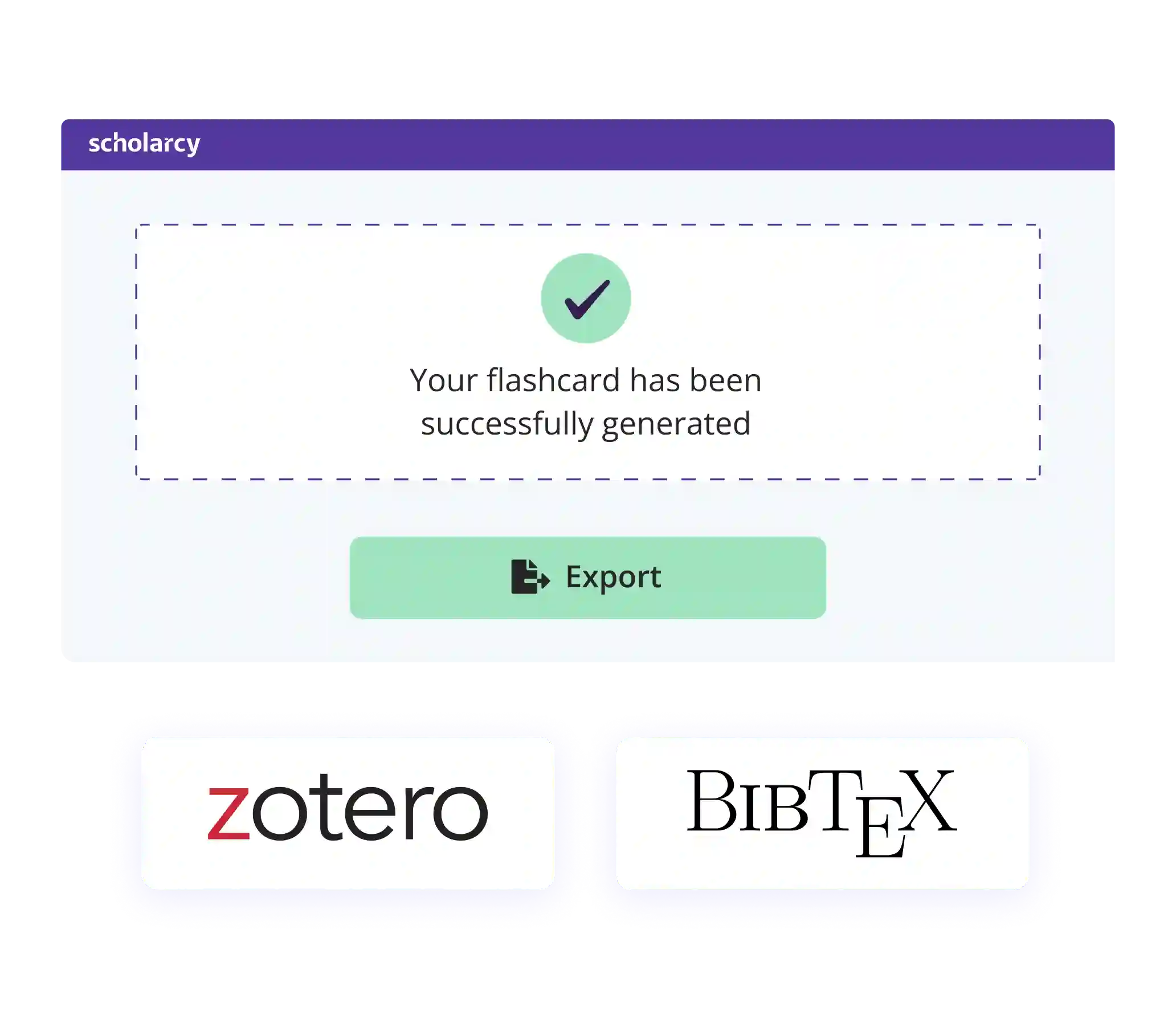
Each flashcard contains:
Key methods and results
Important claims and findings highlighted
Direct links to the full text of cited sources
Key concepts and their definitions
Comparative Analysis – see how the paper compares to earlier studies
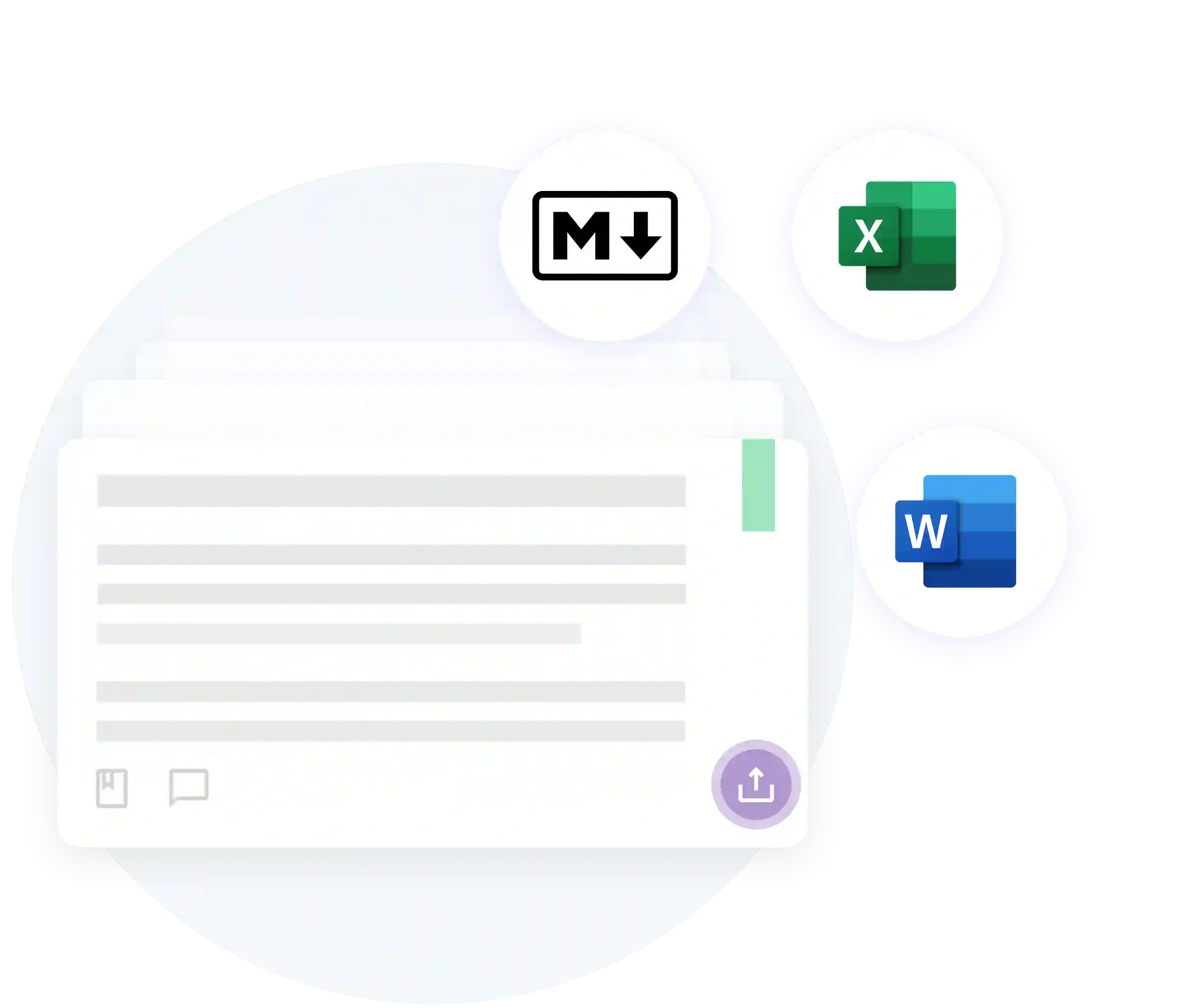
Need more than just a summary?
Upgrade to Scholarcy Library and build a personal research library by turning your collections of papers, RSS feeds, and search results into interactive, summary flashcards that you can read, share and annotate on any device.
You can also export your flashcards to a range of formats including Excel , Word , RIS and Markdown to generate annotated bibliographies, knowledge graphs and more.
What People Are Saying
“Quick processing time, successfully summarized important points”
“It’s really good for case study analysis, thank you for this too”
“I love this website so much it has made my research a lot easier thanks!”
“The instant feedback I get from this tool is amazing”
“Thank you for making my life easier”
“I don’t think I could have attained my Master’s in Systems Thinking without this fantastic platform.”
“Scholarcy is a great tool and helped me immensely with my studies”
- Resources Home 🏠
- Try SciSpace Copilot
- Search research papers
- Add Copilot Extension
- Try AI Detector
- Try Paraphraser
- Try Citation Generator
- April Papers
- June Papers
- July Papers

5 literature review tools to ace your research (+2 bonus tools)

Table of Contents
Your literature review is the lore behind your research paper . It comes in two forms, systematic and scoping , both serving the purpose of rounding up previously published works in your research area that led you to write and finish your own.
A literature review is vital as it provides the reader with a critical overview of the existing body of knowledge, your methodology, and an opportunity for research applications.

Some steps to follow while writing your review:
- Pick an accessible topic for your paper
- Do thorough research and gather evidence surrounding your topic
- Read and take notes diligently
- Create a rough structure for your review
- Synthesis your notes and write the first draft
- Edit and proofread your literature review
To make your workload a little lighter, there are many literature review AI tools. These tools can help you find academic articles through AI and answer questions about a research paper.
Best literature review tools to improve research workflow
A literature review is one of the most critical yet tedious stages in composing a research paper. Many students find it an uphill task since it requires extensive reading and careful organization .
Using some of the best literature review tools listed here, you can make your life easier by overcoming some of the existing challenges in literature reviews. From collecting and classifying to analyzing and publishing research outputs, these tools help you with your literature review and improve your productivity without additional effort or expenses.
1. SciSpace
SciSpace is an AI for academic research that will help find research papers and answer questions about a research paper. You can discover, read, and understand research papers with SciSpace making it an excellent platform for literature review. Featuring a repository with over 270 million research papers, it comes with your AI research assistant called Copilot that offers explanations, summaries , and answers as you read.
Get started now:
Find academic articles through AI
SciSpace has a dedicated literature review tool that finds scientific articles when you search for a question. Based on semantic search, it shows all the research papers relevant for your subject. You can then gather quick insights for all the papers displayed in your search results like methodology, dataset, etc., and figure out all the papers relevant for your research.
Identify relevant articles faster
Abstracts are not always enough to determine whether a paper is relevant to your research question. For starters, you can ask questions to your AI research assistant, SciSpace Copilot to explore the content and better understand the article. Additionally, use the summarize feature to quickly review the methodology and results of a paper and decide if it is worth reading in detail.

Learn in your preferred language
A big barrier non-native English speakers face while conducting a literature review is that a significant portion of scientific literature is published in English. But with SciSpace Copilot, you can review, interact, and learn from research papers in any language you prefer — presently, it supports 75+ languages. The AI will answer questions about a research paper in your mother tongue.
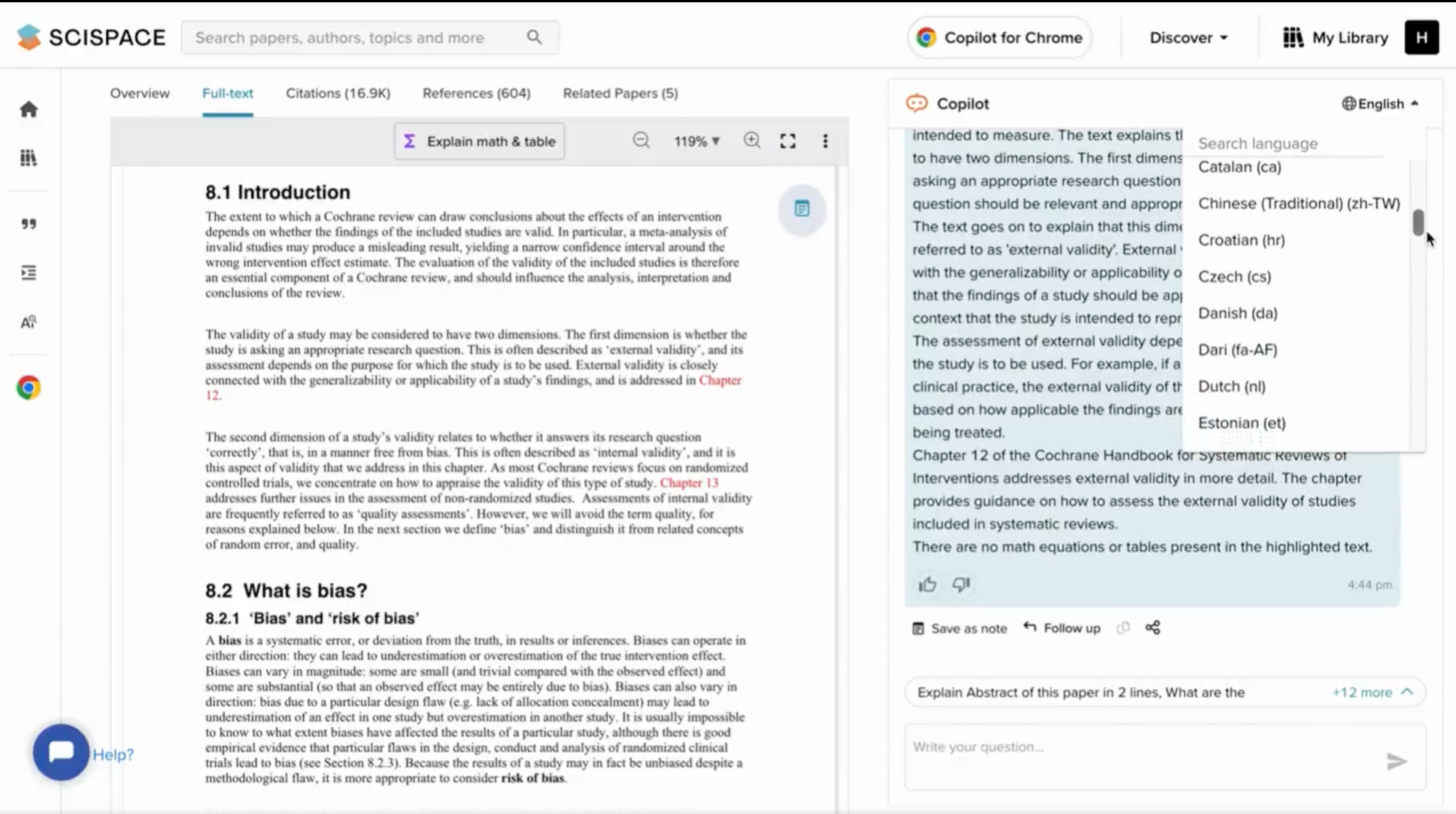
Integrates with Zotero
Many researchers use Zotero to create a library and manage research papers. SciSpace lets you import your scientific articles directly from Zotero into your SciSpace library and use Copilot to comprehend your research papers. You can also highlight key sections, add notes to the PDF as you read, and even turn helpful explanations and answers from Copilot into notes for future review.
Understand math and complex concepts quickly
Come across complex mathematical equations or difficult concepts? Simply highlight the text or select the formula or table, and Copilot will provide an explanation or breakdown of the same in an easy-to-understand manner. You can ask follow-up questions if you need further clarification.

Discover new papers to read without leaving
Highlight phrases or sentences in your research paper to get suggestions for related papers in the field and save time on literature reviews. You can also use the 'Trace' feature to move across and discover connected papers, authors, topics, and more.
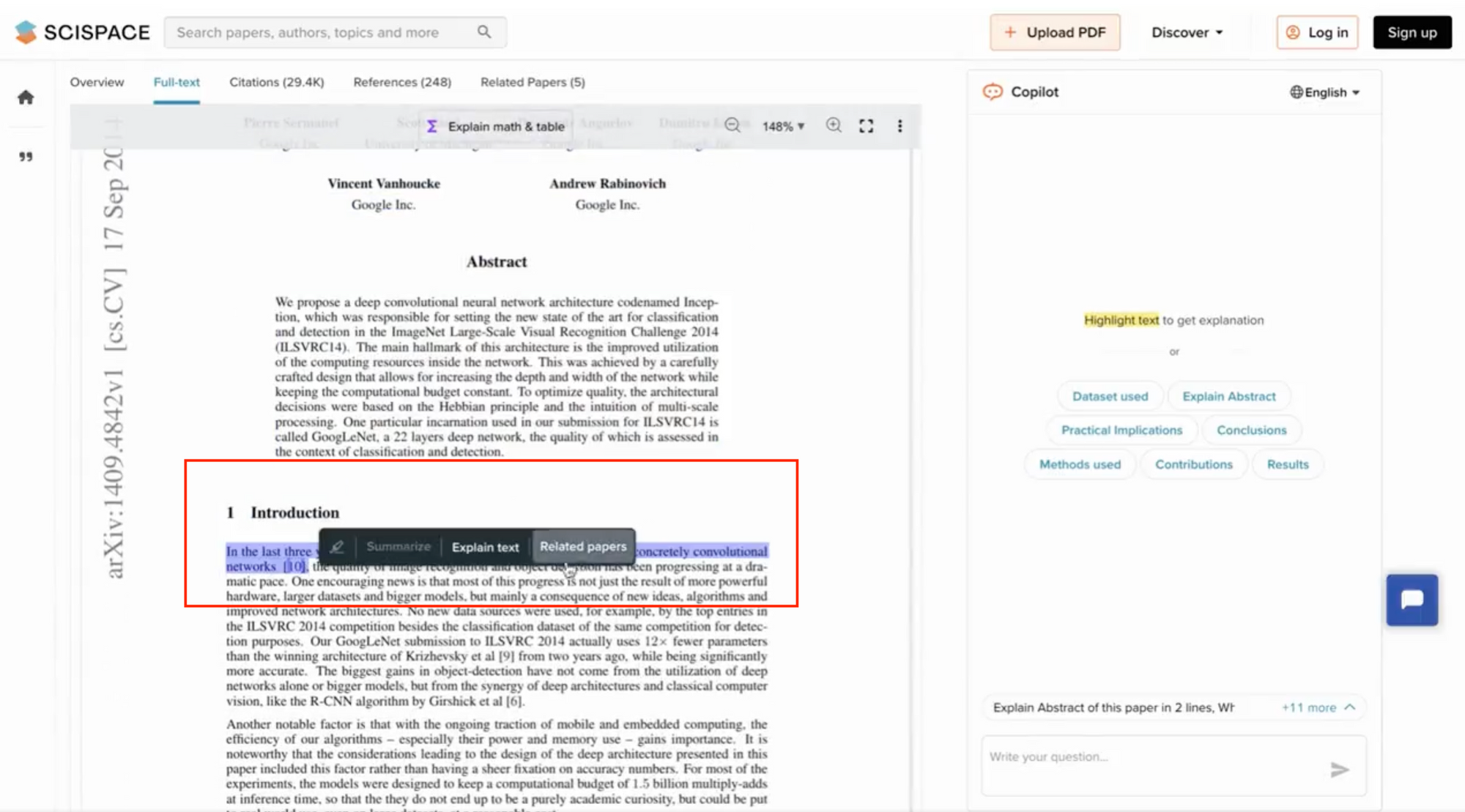
SciSpace Copilot is now available as a Chrome extension , allowing you to access its features directly while you browse scientific literature anywhere across the web.
Get citation-backed answers
When you're conducting a literature review, you want credible information with proper references. Copilot ensures that every piece of information provided by SciSpace Copilot is backed by a direct reference, boosting transparency, accuracy, and trustworthiness.
Ask a question related to the paper you're delving into. Every response from Copilot comes with a clickable citation. This citation leads you straight to the section of the PDF from which the answer was extracted.
By seamlessly integrating answers with citations, SciSpace Copilot assures you of the authenticity and relevance of the information you receive.
2. Mendeley
Mendeley Citation Manager is a free web and desktop application. It helps simplify your citation management workflow significantly. Here are some ways you can speed up your referencing game with Mendeley.
Generate citations and bibliographies
Easily add references from your Mendeley library to your Word document, change your citation style, and create a bibliography, all without leaving your document.
Retrieve references
It allows you to access your references quickly. Search for a term, and it will return results by referencing the year, author, or source.
Add sources to your Mendeley library by dragging PDF to Mendeley Reference Manager. Mendeley will automatically remove the PDF(s) metadata and create a library entry.
Read and annotate documents
It helps you highlight and comment across multiple PDFs while keep them all in one place using Mendeley Notebook . Notebook pages are not tied to a reference and let you quote from many PDFs.
A big part of many literature review workflows, Zotero is a free, open-source tool for managing citations that works as a plug-in on your browser. It helps you gather the information you need, cite your sources, lets you attach PDFs, notes, and images to your citations, and create bibliographies.
Import research articles to your database
Search for research articles on a keyword, and add relevant results to your database. Then, select the articles you are most interested in, and import them into Zotero.
Add bibliography in a variety of formats
With Zotero, you don’t have to scramble for different bibliography formats. Simply use the Zotero-Word plug-in to insert in-text citations and generate a bibliography.
Share your research
You can save a paper and sync it with an online library to easily share your research for group projects. Zotero can be used to create your database and decrease the time you spend formatting citations.
Sysrev is an AI too for article review that facilitates screening, collaboration, and data extraction from academic publications, abstracts, and PDF documents using machine learning. The platform is free and supports public and Open Access projects only.
Some of the features of Sysrev include:
Group labels
Group labels can be a powerful concept for creating database tables from documents. When exported and re-imported, each group label creates a new table. To make labels for a project, go into the manage -> labels section of the project.
Group labels enable project managers to pull table information from documents. It makes it easier to communicate review results for specific articles.
Track reviewer performance
Sysrev's label counting tool provides filtering and visualization options for keeping track of the distribution of labels throughout the project's progress. Project managers can check their projects at any point to track progress and the reviewer's performance.
Tool for concordance
The Sysrev tool for concordance allows project administrators and reviewers to perform analysis on their labels. Concordance is measured by calculating the number of times users agree on the labels they have extracted.
Colandr is a free, open-source, internet-based analysis and screening software used as an AI for academic research. It was designed to ease collaboration across various stages of the systematic review procedure. The tool can be a little complex to use. So, here are the steps involved in working with Colandr.
Create a review
The first step to using Colandr is setting up an organized review project. This is helpful to librarians who are assisting researchers with systematic reviews.
The planning stage is setting the review's objectives along with research queries. Any reviewer can review the details of the planning stage. However, they can only be modified by the author for the review.
Citation screening/import
In this phase, users can upload their results from database searches. Colandr also offers an automated deduplication system.
Full-text screening
The system in Colandr will discover the combination of terms and expressions that are most useful for the reader. If an article is selected, it will be moved to the final step.
Data extraction/export
Colandr data extraction is more efficient than the manual method. It creates the form fields for data extraction during the planning stage of the review procedure. Users can decide to revisit or modify the form for data extraction after completing the initial screening.
Bonus literature review tools
SRDR+ is a web-based tool for extracting and managing systematic review or meta-analysis data. It is open and has a searchable archive of systematic reviews and their data.
7. Plot Digitizer
Plot Digitizer is an efficient tool for extracting information from graphs and images, equipped with many features that facilitate data extraction. The program comes with a free online application, which is adequate to extract data quickly.
Final thoughts
Writing a literature review is not easy. It’s a time-consuming process, which can become tiring at times. The literature review tools mentioned in this blog do an excellent job of maximizing your efforts and helping you write literature reviews much more efficiently. With them, you can breathe a sigh of relief and give more time to your research.
As you dive into your literature review, don’t forget to use SciSpace ResearchGPT to streamline the process. It facilitates your research and helps you explore key findings, summary, and other components of the paper easily.
Frequently Asked Questions (FAQs)
1. what is rrl in research.
RRL stands for Review of Related Literature and sometimes interchanged with ‘Literature Review.’ RRL is a body of studies relevant to the topic being researched. These studies may be in the form of journal articles, books, reports, and other similar documents. Review of related literature is used to support an argument or theory being made by the researcher, as well as to provide information on how others have approached the same topic.
2. What are few softwares and tools available for literature review?
• SciSpace Discover
• Mendeley
• Zotero
• Sysrev
• Colandr
• SRDR+
3. How to generate an online literature review?
The Scispace Discover tool, which offers an excellent repository of millions of peer-reviewed articles and resources, will help you generate or create a literature review easily. You may find relevant information by utilizing the filter option, checking its credibility, tracing related topics and articles, and citing in widely accepted formats with a single click.
4. What does it mean to synthesize literature?
To synthesize literature is to take the main points and ideas from a number of sources and present them in a new way. The goal is to create a new piece of writing that pulls together the most important elements of all the sources you read. Make recommendations based on them, and connect them to the research.
5. Should we write abstract for literature review?
Abstracts, particularly for the literature review section, are not required. However, an abstract for the research paper, on the whole, is useful for summarizing the paper and letting readers know what to expect from it. It can also be used to summarize the main points of the paper so that readers have a better understanding of the paper's content before they read it.
6. How do you evaluate the quality of a literature review?
• Whether it is clear and well-written.
• Whether Information is current and up to date.
• Does it cover all of the relevant sources on the topic.
• Does it provide enough evidence to support its conclusions.
7. Is literature review mandatory?
Yes. Literature review is a mandatory part of any research project. It is a critical step in the process that allows you to establish the scope of your research and provide a background for the rest of your work.
8. What are the sources for a literature review?
• Reports
• Theses
• Conference proceedings
• Company reports
• Some government publications
• Journals
• Books
• Newspapers
• Articles by professional associations
• Indexes
• Databases
• Catalogues
• Encyclopaedias
• Dictionaries
• Bibliographies
• Citation indexes
• Statistical data from government websites
9. What is the difference between a systematic review and a literature review?
A systematic review is a form of research that uses a rigorous method to generate knowledge from both published and unpublished data. A literature review, on the other hand, is a critical summary of an area of research within the context of what has already been published.
Suggested reads!
Types of essays in academic writing Citation Machine Alternatives — A comparison of top citation tools 2023
QuillBot vs SciSpace: Choose the best AI-paraphrasing tool
ChatPDF vs. SciSpace Copilot: Unveiling the best tool for your research
You might also like

Consensus GPT vs. SciSpace GPT: Choose the Best GPT for Research

Literature Review and Theoretical Framework: Understanding the Differences

Types of Essays in Academic Writing - Quick Guide (2024)
Free Online Article Critique Generator for Students
Need help writing an article critique? You’ve come to the right place! This free online article critique generator will help you get inspired with ideas for an outstanding analysis.
- 🤖 How to Use
- ✨ Benefits of Our Generator
🔬 What Is an Article Critique?
- ️✍️ How to Critique an Article
- 📑 Best Critique Example
🔎 References
🤖 free article critique generator: how to use.
- Type in the title of the article you want to analyze.
- State the name of its author.
- Paste the text of the article. Mind that you can enter up to 2000 words. If your text is longer than that, you can condense it using our summarizer .
- Press "Analyze" to get your customized sample review.
✨ Benefits of Our Free Online Article Critique Generator
Want to know more about our article critique generator? Check out its unique advantages:
An article critique is a type of academic writing that requires you to analyze an article in detail. Typically, it deals with scientific journals, but it can also focus on other types of content, such as magazines and newspapers.
A typical critique includes a detailed summary of the article’s main points. It also examines the author's claims along with the text’s overall strengths and weaknesses.

Article Critique vs. Summary
While article critique involves a summary of the text's main points, it’s more than just a simple overview:
- Aside from presenting a synopsis , an article critique requires you to review the text in-depth and identify its weaknesses and strengths.
- In contrast, a summary doesn’t include any analysis. Instead, it simply retells the text's contents.
✍️ How to Critique an Article
Now that you know what an article critique is, let's see how you can write it. It may seem intimidating and time-consuming, especially if it's your first time working on such an assignment. Worry not: with our guidance, the task will be a piece of cake.
Follow our tips below, and you'll have a perfect article critique in no time! And if you need additional inspiration, our free article critique generator is here to assist you.
Before You Start
A successful critique starts with attentive reading. Here's how you can get the most out of it:
- Read the entire article and try to identify its main idea .
- Look up unfamiliar words to get a better understanding of the text.
- Carefully reread the article. This time, focus on identifying ideas that support the text’s point.
- Summarize the article in one or two sentences using your own words.
- Reread the article once again. This time, analyze how the author supports their ideas. Pay particular attention to examples, facts, opinions, and biases.
- Consider if the author's ideas are convincing and objective.

Once you’re done reading and preparing, it’s time to start writing.
How Does an Article Critique Begin?
The introduction is the first thing your readers will see, so it's essential to make it impressive and catchy. Here's what a good opening paragraph should include:
- A brief presentation of the article and its author.
- An overview of the text's central idea.
- A thesis statement that describes your observations and outlines how you will discuss the article. A well-written thesis will help your readers grasp the direction of your critique.
What to Include in an Article Critique Body
The body is where you present and support your ideas. You can divide it into two parts: the first summarizes the article, and the second examines and critiques it.
In the summary, discuss the following aspects:
- The text’s main ideas.
- The arguments that support these ideas.
- The author's conclusions or research findings.
- The broader context in which the article is situated.
After summarizing the text, you can move on to the critique that involves:
- The discussion of the article's strengths and weaknesses.
- Ethical considerations the study raises, if there are any.
- Evaluation of the research methodology or argumentation, including its potential limitations.
- Your opinions regarding the article's relevance, accuracy, and clarity of presentation.
- Specific examples from the article that support your statements.
How to Write an Article Critique Conclusion
The conclusion is the last part of your work that leaves one last impression on your readers. A perfect conclusion should include:
- A very brief recap of the article.
- A summary of your analysis.
- Evaluation of the work's value, relevance, and importance.
📑 Best Article Critique Example
Below, you will find an excellent critique of a magazine article taken from The New Yorker . Check it out:
"'Film Noir': The Elusive Genre" by Richard Brody: Article Critique
The article "'Film Noir': The Elusive Genre" by Richard Brody discusses the nature of film noir as a genre. It reflects on the use of the term "noir" in defining two film series, Femmes Noir at Film Forum and Lady in the Dark: Crime Films from Columbia Pictures, 1932-1957 at the Museum of Modern Art (MoMA). The author discusses the peculiarities of film noir and compares it with other genres that can be easily identified through visual elements or themes. The author considers the absence of the term "noir" in the MoMA series reasonable due to the historical context and the genre's unique characteristics.
The article examines the historical background of the term "film noir" and its absence in early discussions about the genre. It mentions the French critic Nino Frank, who coined the term in 1946. Richard Brody explains that French critics believed film noir movies focus more on psychological narratives and character studies than traditional crime procedurals. This made them unique and deserving of being put into a separate category. The French critics of the postwar years saw these films as a continuation of European filmmakers' efforts to expose corruption and injustice through cinema. The article also touches on the opposition between critics associated with Positif and Cahiers du Cinéma . It highlights and dives more into the political and sociological aspects that French critics appreciated in film noir.
Richard Brody's article provides a comprehensive historical overview of the term "film noir" and mentions its reception and the genre's development thanks to French criticism. However, the writing could be improved if the author included the analysis of the MoMA series. The author could also elaborate on how MoMA's avoidance of the term aligns with his perspective. Additionally, the article could further explore film noir's impact and legacy on contemporary filmmaking and culture. While the historical context is well-presented, a deeper exploration of the genre's lasting impact would add to the article.
Richard Brody's article "'Film Noir': The Elusive Genre" effectively delves into the historical origins of the term "film noir" and its reception by French critics. The author supports MoMA's decision to focus on the element of crime rather than explicitly using the term "noir" in their series. The discussion on the historical origin of film noir as a genre and its connection to social and political contexts presented in the article helps readers understand the cinematic style better. However, a more in-depth analysis of the MoMA series and the discussion of film noir's contemporary relevance would add a new layer to this work.
Now, you're all set to start working on your own article critique! Our free online generator will help you find inspiration and provide you with even more examples. Try it now, and have fun!
If you're looking for further writing assistance, you can also check out our rhetorical device finder and poem checker .
- How to Write an Article Critique: Boston University
- Writing a Critique: Hunter College
- How to Write an Article Critique: Verywell Mind
- A Guide for Critique of Research Articles: California State University, Long Beach
- Writing a Critique: University College London

AI Literature Review Generator
Generate high-quality literature reviews fast with ai.
- Academic Research: Create a literature review for your thesis, dissertation, or research paper.
- Professional Research: Conduct a literature review for a project, report, or proposal at work.
- Content Creation: Write a literature review for a blog post, article, or book.
- Personal Research: Conduct a literature review to deepen your understanding of a topic of interest.
New & Trending Tools
Ai text generator, webpage text extractor ai.
All-in-one Literature Review Software
Start your free trial.
Free MAXQDA trial for Windows and Mac
Your trial will end automatically after 14 days.
MAXQDA The All-in-one Literature Review Software
MAXQDA is the best choice for a comprehensive literature review. It works with a wide range of data types and offers powerful tools for literature review, such as reference management, qualitative, vocabulary, text analysis tools, and more.
Document viewer
Your analysis.
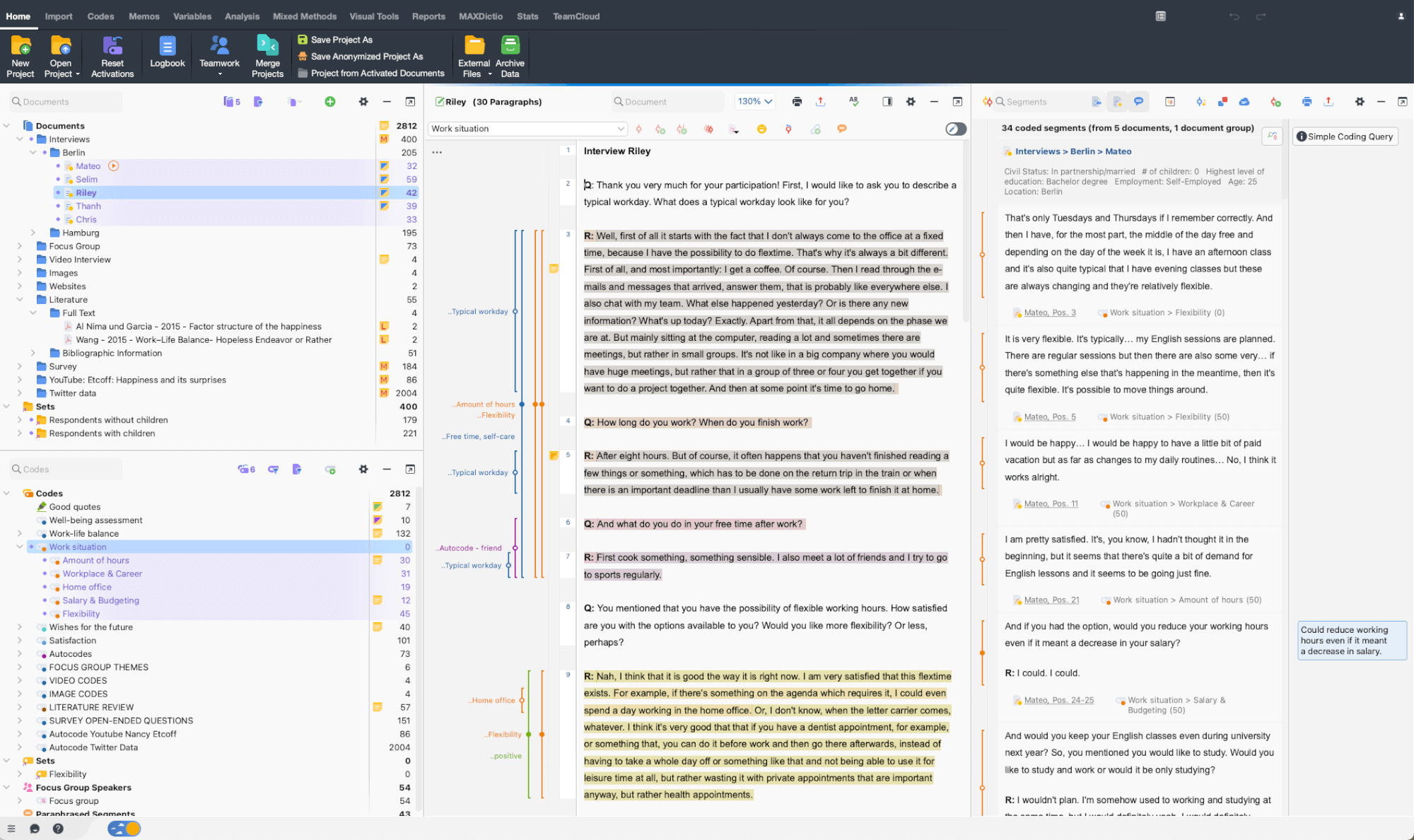
As your all-in-one literature review software, MAXQDA can be used to manage your entire research project. Easily import data from texts, interviews, focus groups, PDFs, web pages, spreadsheets, articles, e-books, and even social media data. Connect the reference management system of your choice with MAXQDA to easily import bibliographic data. Organize your data in groups, link relevant quotes to each other, keep track of your literature summaries, and share and compare work with your team members. Your project file stays flexible and you can expand and refine your category system as you go to suit your research.
Developed by and for researchers – since 1989

Having used several qualitative data analysis software programs, there is no doubt in my mind that MAXQDA has advantages over all the others. In addition to its remarkable analytical features for harnessing data, MAXQDA’s stellar customer service, online tutorials, and global learning community make it a user friendly and top-notch product.
Sally S. Cohen – NYU Rory Meyers College of Nursing
Literature Review is Faster and Smarter with MAXQDA

Easily import your literature review data
With a literature review software like MAXQDA, you can easily import bibliographic data from reference management programs for your literature review. MAXQDA can work with all reference management programs that can export their databases in RIS-format which is a standard format for bibliographic information. Like MAXQDA, these reference managers use project files, containing all collected bibliographic information, such as author, title, links to websites, keywords, abstracts, and other information. In addition, you can easily import the corresponding full texts. Upon import, all documents will be automatically pre-coded to facilitate your literature review at a later stage.
Capture your ideas while analyzing your literature
Great ideas will often occur to you while you’re doing your literature review. Using MAXQDA as your literature review software, you can create memos to store your ideas, such as research questions and objectives, or you can use memos for paraphrasing passages into your own words. By attaching memos like post-it notes to text passages, texts, document groups, images, audio/video clips, and of course codes, you can easily retrieve them at a later stage. Particularly useful for literature reviews are free memos written during the course of work from which passages can be copied and inserted into the final text.
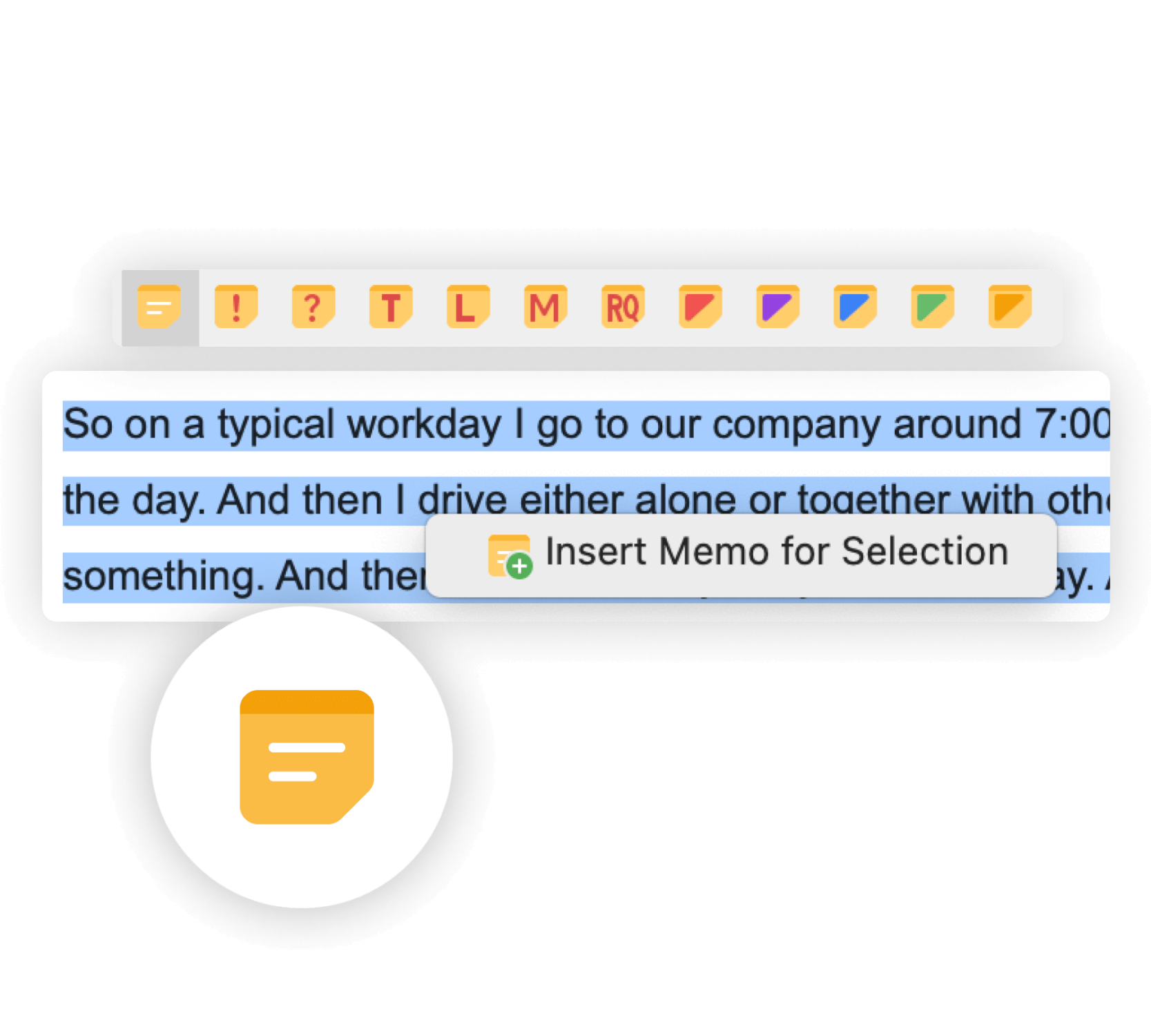
Find concepts important to your generated literature review
When generating a literature review you might need to analyze a large amount of text. Luckily MAXQDA as the #1 literature review software offers Text Search tools that allow you to explore your documents without reading or coding them first. Automatically search for keywords (or dictionaries of keywords), such as important concepts for your literature review, and automatically code them with just a few clicks. Document variables that were automatically created during the import of your bibliographic information can be used for searching and retrieving certain text segments. MAXQDA’s powerful Coding Query allows you to analyze the combination of activated codes in different ways.
Aggregate your literature review
When conducting a literature review you can easily get lost. But with MAXQDA as your literature review software, you will never lose track of the bigger picture. Among other tools, MAXQDA’s overview and summary tables are especially useful for aggregating your literature review results. MAXQDA offers overview tables for almost everything, codes, memos, coded segments, links, and so on. With MAXQDA literature review tools you can create compressed summaries of sources that can be effectively compared and represented, and with just one click you can easily export your overview and summary tables and integrate them into your literature review report.
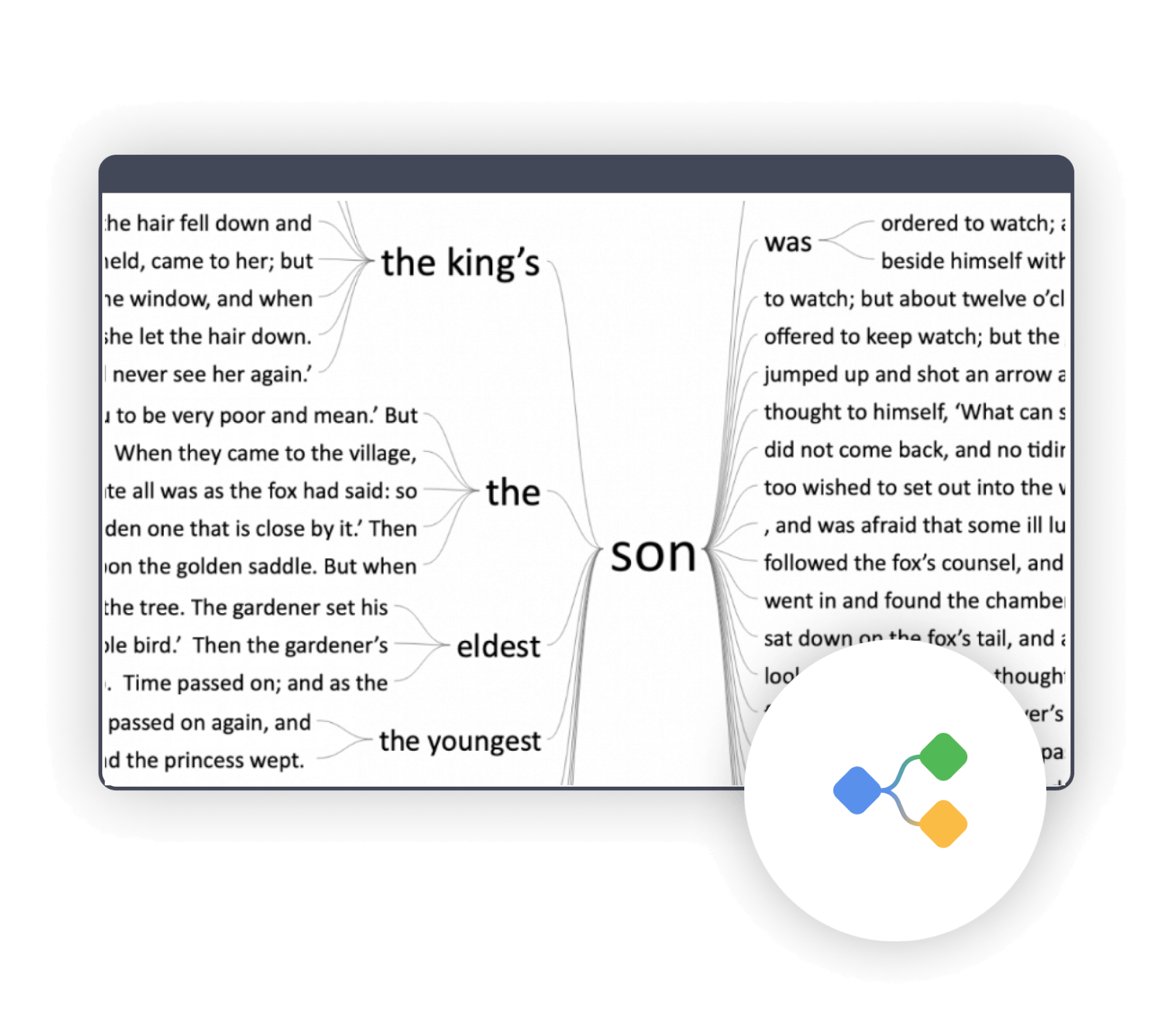
Powerful and easy-to-use literature review tools
Quantitative aspects can also be relevant when conducting a literature review analysis. Using MAXQDA as your literature review software enables you to employ a vast range of procedures for the quantitative evaluation of your material. You can sort sources according to document variables, compare amounts with frequency tables and charts, and much more. Make sure you don’t miss the word frequency tools of MAXQDA’s add-on module for quantitative content analysis. Included are tools for visual text exploration, content analysis, vocabulary analysis, dictionary-based analysis, and more that facilitate the quantitative analysis of terms and their semantic contexts.
Visualize your literature review
As an all-in-one literature review software, MAXQDA offers a variety of visual tools that are tailor-made for qualitative research and literature reviews. Create stunning visualizations to analyze your material. Of course, you can export your visualizations in various formats to enrich your literature review analysis report. Work with word clouds to explore the central themes of a text and key terms that are used, create charts to easily compare the occurrences of concepts and important keywords, or make use of the graphical representation possibilities of MAXMaps, which in particular permit the creation of concept maps. Thanks to the interactive connection between your visualizations with your MAXQDA data, you’ll never lose sight of the big picture.
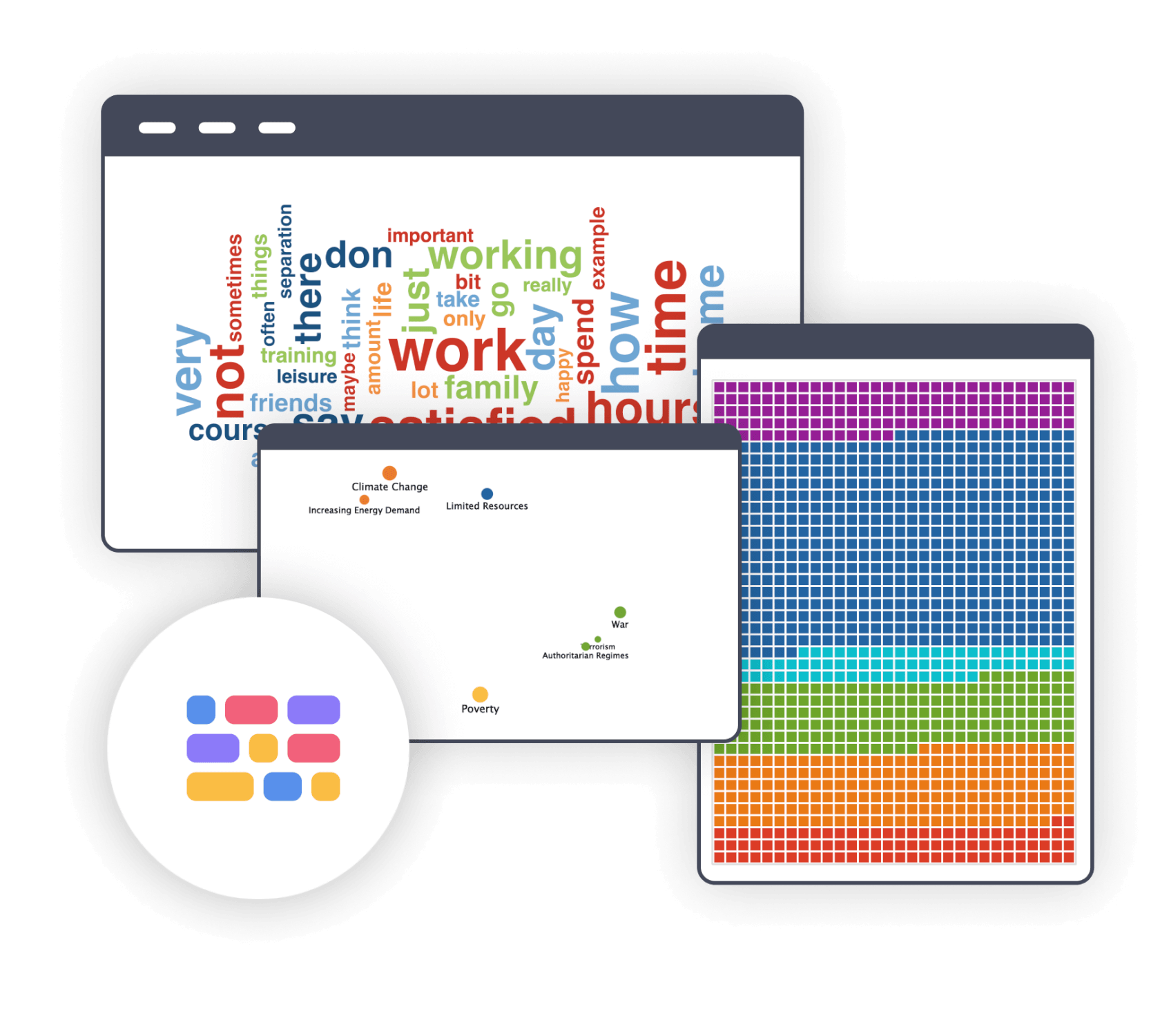
AI Assist: literature review software meets AI
AI Assist – your virtual research assistant – supports your literature review with various tools. AI Assist simplifies your work by automatically analyzing and summarizing elements of your research project and by generating suggestions for subcodes. No matter which AI tool you use – you can customize your results to suit your needs.
Free tutorials and guides on literature review
MAXQDA offers a variety of free learning resources for literature review, making it easy for both beginners and advanced users to learn how to use the software. From free video tutorials and webinars to step-by-step guides and sample projects, these resources provide a wealth of information to help you understand the features and functionality of MAXQDA for literature review. For beginners, the software’s user-friendly interface and comprehensive help center make it easy to get started with your data analysis, while advanced users will appreciate the detailed guides and tutorials that cover more complex features and techniques. Whether you’re just starting out or are an experienced researcher, MAXQDA’s free learning resources will help you get the most out of your literature review.
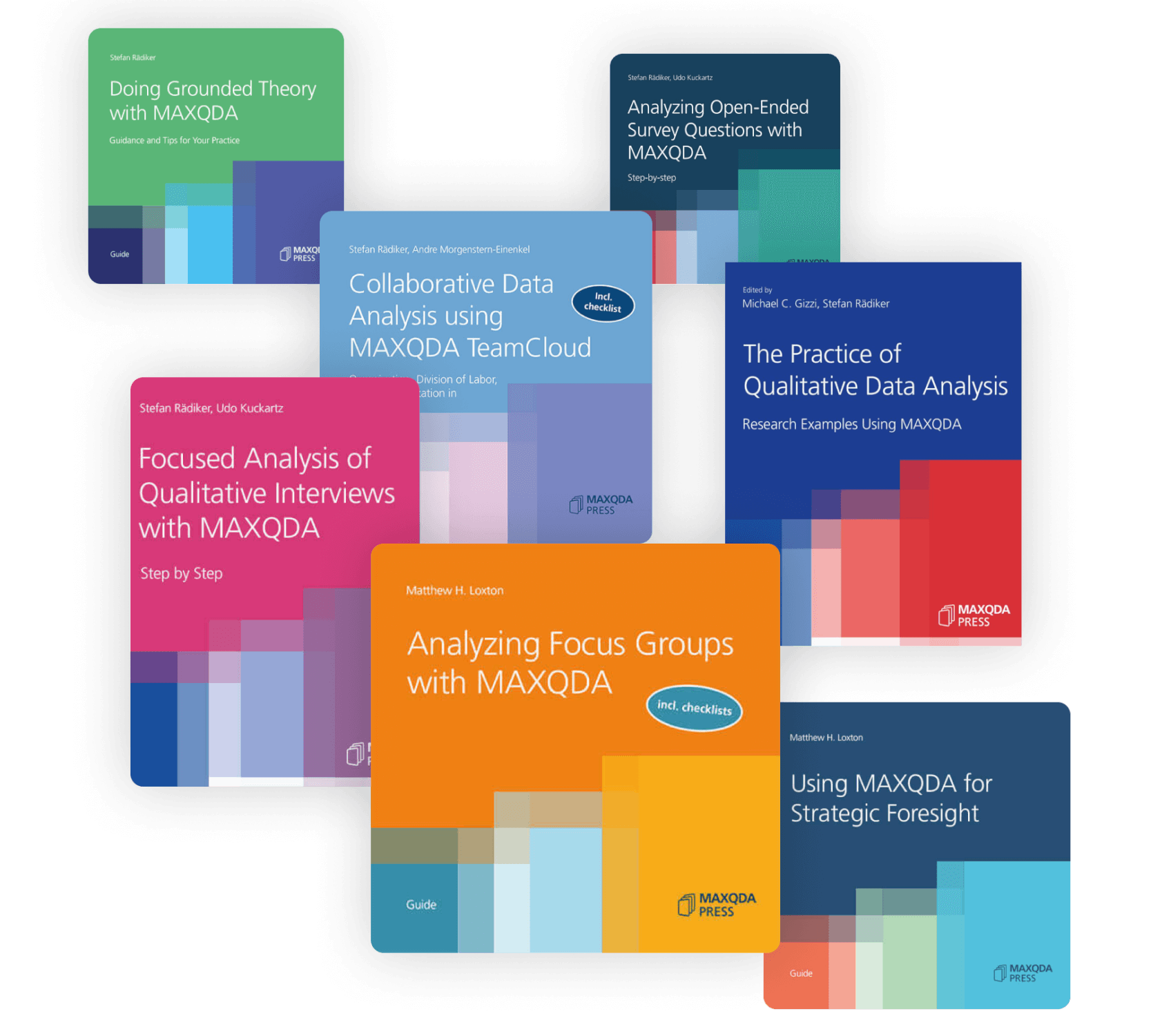
Free MAXQDA Trial for Windows and Mac
Get your maxqda license, compare the features of maxqda and maxqda analytics pro, faq: literature review software.
Literature review software is a tool designed to help researchers efficiently manage and analyze the existing body of literature relevant to their research topic. MAXQDA, a versatile qualitative data analysis tool, can be instrumental in this process.
Literature review software, like MAXQDA, typically includes features such as data import and organization, coding and categorization, advanced search capabilities, data visualization tools, and collaboration features. These features facilitate the systematic review and analysis of relevant literature.
Literature review software, including MAXQDA, can assist in qualitative data interpretation by enabling researchers to organize, code, and categorize relevant literature. This organized data can then be analyzed to identify trends, patterns, and themes, helping researchers draw meaningful insights from the literature they’ve reviewed.
Yes, literature review software like MAXQDA is suitable for researchers of all levels of experience. It offers user-friendly interfaces and extensive support resources, making it accessible to beginners while providing advanced features that cater to the needs of experienced researchers.
Getting started with literature review software, such as MAXQDA, typically involves downloading and installing the software, importing your relevant literature, and exploring the available features. Many software providers offer tutorials and documentation to help users get started quickly.
For students, MAXQDA can be an excellent literature review software choice. Its user-friendly interface, comprehensive feature set, and educational discounts make it a valuable tool for students conducting literature reviews as part of their academic research.
MAXQDA is available for both Windows and Mac users, making it a suitable choice for Mac users looking for literature review software. It offers a consistent and feature-rich experience on Mac operating systems.
When it comes to literature review software, MAXQDA is widely regarded as one of the best choices. Its robust feature set, user-friendly interface, and versatility make it a top pick for researchers conducting literature reviews.
Yes, literature reviews can be conducted without software. However, using literature review software like MAXQDA can significantly streamline and enhance the process by providing tools for efficient data management, analysis, and visualization.
- Terms & Conditions
- Tools Suggest
Review Generator
Write about your review topic in one line..
Example: For computer institute or coaching centre

Unlike many other AI writer tools, WriterHand.com is completely free to use. There are no subscription fees or hidden costs, and you can use the tool as much as you want without any limitations.

Easy to Use
WriterHand.com has been designed with simplicity in mind. There's no need to sign up or create an account - you can simply start using the tool right away. The user-friendly design and simple controls make it easy for anyone.

Time Saving
With WriterHand.com, you can start writing with just one click. The tool generates content that is well-structured and coherent, which means you can spend less time editing and more time focusing on other tasks.
In the digital age, online reviews play a pivotal role in shaping consumer decisions. Whether it's purchasing a product, booking a hotel, or trying out a new restaurant, people heavily rely on reviews to inform their choices. This reliance has led to an increasing demand for review generation tools that can save time and effort while maintaining quality. WriterHand.com has taken the lead in this field with its groundbreaking 100% free Review Generator AI. In this article, we will explore the features and benefits of this powerful tool and how it can revolutionize the way writers and businesses generate authentic and persuasive reviews.
Generating Quality Reviews Effortlessly
WriterHand.com's Review Generator AI employs state-of-the-art natural language processing algorithms to produce high-quality reviews in a matter of seconds. The tool is designed to cater to the needs of both individual writers and businesses seeking to enhance their online presence. By simply inputting a few key details about a product, service, or experience, users can obtain well-crafted reviews that reflect a genuine customer's perspective.
Customization and Flexibility
One of the standout features of WriterHand.com's Review Generator AI is its versatility and customization options. The tool allows users to adjust the tone, length, and style of the generated reviews to align with their specific requirements. Whether you prefer a formal, professional tone for a corporate setting or a casual, friendly style for a restaurant review, the AI can adapt accordingly. This flexibility ensures that the generated reviews resonate with the target audience and accurately reflect the intended message.
Time-Saving Solution
Writing engaging and persuasive reviews can be a time-consuming task, especially when businesses or individuals have numerous products or services to showcase. WriterHand.com's Review Generator AI streamlines the process, enabling users to generate multiple reviews effortlessly and rapidly. This not only saves valuable time but also allows businesses to focus on core operations and writers to allocate their energy to other creative endeavors.
Authenticity and Credibility
One of the concerns with automated review generation is the potential lack of authenticity and credibility. However, WriterHand.com's Review Generator AI addresses this issue by producing reviews that feel genuine and believable. The AI model has been trained on vast amounts of real customer reviews, ensuring that the generated content reflects the nuances and language patterns found in authentic user feedback. This authenticity enhances the credibility of the reviews and boosts trust among potential customers.
Free of Charge
Perhaps the most compelling aspect of WriterHand.com's Review Generator AI is its accessibility. The tool is offered completely free of charge, allowing businesses and individuals to harness the power of AI-generated reviews without any financial burden. This democratization of review generation technology enables even small businesses and budding writers to compete in the digital marketplace on an equal footing with larger enterprises.
WriterHand.com's 100% free Review Generator AI is a game-changer in the field of review generation. With its ability to generate high-quality reviews effortlessly, its customization options, and its focus on authenticity and credibility, this tool is a valuable asset for writers and businesses alike. By saving time, amplifying online presence, and building trust among consumers, WriterHand.com's Review Generator AI has the potential to reshape the way we approach online reviews, benefiting both creators and consumers in the process.
Popular Writer Tools
- Tools Suggest
AI Review Generator
The best way to get unbiased reviews of products and services, write about your review topic in one line..
Example: For computer institute or coaching centre

Related Tools
Looking for a tool to help you generate reviews for your business? Check out AI Review Generator! This tool can help you create fake reviews that look real, helping you boost your business and reputation.
How does an review generator tool work
An review generator tool is a web tool allows you to automatically generate reviews for a product or service. This can be done by scraping review sites or by using natural language processing to generate fake reviews.
What are the benefits of using an AI review generator tool
If you are looking for a way to get more reviews for your business, product, or service, you may want to consider using an AI review generator tool. This type of tool can help you to automatically generate reviews from real people, which can help to improve your online reputation and visibility.
There are a number of benefits that you can enjoy by using an AI review generator tool, including:
1. Increased online visibility: When you have more reviews, you are more likely to show up in search engine results pages (SERPs), which can help you to attract more customers and boost your bottom line.
2. improved customer satisfaction: Customers are more likely to be satisfied with your business if they can see that you have a good online reputation. By using an AI review generator tool, you can help to ensure that your customers are happy with their experience.
3. Boosted search engine optimization (SEO): Good reviews can help to improve your website's SEO, making it easier for customers to find you online.
4. More social proof: Social proof is an important factor in consumer decision-making, and reviews can help to provide it. Having more reviews can make it more likely that people will trust your business and be more.
Content Writing Tools
Book & story writing.

Poem & Lyrics Writing
Letter writing tools, re-writing tools, more writing tools.
THE PAPER REVIEW GENERATOR
This tool is designed to speed up writing reviews for research papers for computer science. It provides a list of items that can be used to automatically generate a review draft. This website should not replace a human. Generated text should be edited by the reviewer to add more details.
How to use? Click on the check-boxes below and the review will be auto-generated according to your selection.
Introduction
Related work, problem definition, experiments, reproducibility, the generated review.
About this tool
This website is designed by Philippe Fournier-Viger by modifying the Autoreject project of Andreas Zeller (https://autoreject.org/) and replacing the textual content so as to turn what was a joke into a serious tool. By using this website, you agree to use it ethically and responsibly. If you have any suggestions to improve this tool or want to report bugs, you can contact with me . License of webpage: [C.C. Attribution 3.0 Unported license] (https://creativecommons.org/licenses/by/3.0/). License of source code to display content: [MIT license: https://mit-license.org/]. Some other websites by me
Also, I have made some useful online text processing tools .
Our approach
- Responsibility
- Infrastructure
- Try Meta AI
RECOMMENDED READS
- 5 Steps to Getting Started with Llama 2
- The Llama Ecosystem: Past, Present, and Future
- Introducing Code Llama, a state-of-the-art large language model for coding
- Meta and Microsoft Introduce the Next Generation of Llama
- Today, we’re introducing Meta Llama 3, the next generation of our state-of-the-art open source large language model.
- Llama 3 models will soon be available on AWS, Databricks, Google Cloud, Hugging Face, Kaggle, IBM WatsonX, Microsoft Azure, NVIDIA NIM, and Snowflake, and with support from hardware platforms offered by AMD, AWS, Dell, Intel, NVIDIA, and Qualcomm.
- We’re dedicated to developing Llama 3 in a responsible way, and we’re offering various resources to help others use it responsibly as well. This includes introducing new trust and safety tools with Llama Guard 2, Code Shield, and CyberSec Eval 2.
- In the coming months, we expect to introduce new capabilities, longer context windows, additional model sizes, and enhanced performance, and we’ll share the Llama 3 research paper.
- Meta AI, built with Llama 3 technology, is now one of the world’s leading AI assistants that can boost your intelligence and lighten your load—helping you learn, get things done, create content, and connect to make the most out of every moment. You can try Meta AI here .
Today, we’re excited to share the first two models of the next generation of Llama, Meta Llama 3, available for broad use. This release features pretrained and instruction-fine-tuned language models with 8B and 70B parameters that can support a broad range of use cases. This next generation of Llama demonstrates state-of-the-art performance on a wide range of industry benchmarks and offers new capabilities, including improved reasoning. We believe these are the best open source models of their class, period. In support of our longstanding open approach, we’re putting Llama 3 in the hands of the community. We want to kickstart the next wave of innovation in AI across the stack—from applications to developer tools to evals to inference optimizations and more. We can’t wait to see what you build and look forward to your feedback.
Our goals for Llama 3
With Llama 3, we set out to build the best open models that are on par with the best proprietary models available today. We wanted to address developer feedback to increase the overall helpfulness of Llama 3 and are doing so while continuing to play a leading role on responsible use and deployment of LLMs. We are embracing the open source ethos of releasing early and often to enable the community to get access to these models while they are still in development. The text-based models we are releasing today are the first in the Llama 3 collection of models. Our goal in the near future is to make Llama 3 multilingual and multimodal, have longer context, and continue to improve overall performance across core LLM capabilities such as reasoning and coding.
State-of-the-art performance
Our new 8B and 70B parameter Llama 3 models are a major leap over Llama 2 and establish a new state-of-the-art for LLM models at those scales. Thanks to improvements in pretraining and post-training, our pretrained and instruction-fine-tuned models are the best models existing today at the 8B and 70B parameter scale. Improvements in our post-training procedures substantially reduced false refusal rates, improved alignment, and increased diversity in model responses. We also saw greatly improved capabilities like reasoning, code generation, and instruction following making Llama 3 more steerable.

*Please see evaluation details for setting and parameters with which these evaluations are calculated.
In the development of Llama 3, we looked at model performance on standard benchmarks and also sought to optimize for performance for real-world scenarios. To this end, we developed a new high-quality human evaluation set. This evaluation set contains 1,800 prompts that cover 12 key use cases: asking for advice, brainstorming, classification, closed question answering, coding, creative writing, extraction, inhabiting a character/persona, open question answering, reasoning, rewriting, and summarization. To prevent accidental overfitting of our models on this evaluation set, even our own modeling teams do not have access to it. The chart below shows aggregated results of our human evaluations across of these categories and prompts against Claude Sonnet, Mistral Medium, and GPT-3.5.

Preference rankings by human annotators based on this evaluation set highlight the strong performance of our 70B instruction-following model compared to competing models of comparable size in real-world scenarios.
Our pretrained model also establishes a new state-of-the-art for LLM models at those scales.

To develop a great language model, we believe it’s important to innovate, scale, and optimize for simplicity. We adopted this design philosophy throughout the Llama 3 project with a focus on four key ingredients: the model architecture, the pretraining data, scaling up pretraining, and instruction fine-tuning.
Model architecture
In line with our design philosophy, we opted for a relatively standard decoder-only transformer architecture in Llama 3. Compared to Llama 2, we made several key improvements. Llama 3 uses a tokenizer with a vocabulary of 128K tokens that encodes language much more efficiently, which leads to substantially improved model performance. To improve the inference efficiency of Llama 3 models, we’ve adopted grouped query attention (GQA) across both the 8B and 70B sizes. We trained the models on sequences of 8,192 tokens, using a mask to ensure self-attention does not cross document boundaries.
Training data
To train the best language model, the curation of a large, high-quality training dataset is paramount. In line with our design principles, we invested heavily in pretraining data. Llama 3 is pretrained on over 15T tokens that were all collected from publicly available sources. Our training dataset is seven times larger than that used for Llama 2, and it includes four times more code. To prepare for upcoming multilingual use cases, over 5% of the Llama 3 pretraining dataset consists of high-quality non-English data that covers over 30 languages. However, we do not expect the same level of performance in these languages as in English.
To ensure Llama 3 is trained on data of the highest quality, we developed a series of data-filtering pipelines. These pipelines include using heuristic filters, NSFW filters, semantic deduplication approaches, and text classifiers to predict data quality. We found that previous generations of Llama are surprisingly good at identifying high-quality data, hence we used Llama 2 to generate the training data for the text-quality classifiers that are powering Llama 3.
We also performed extensive experiments to evaluate the best ways of mixing data from different sources in our final pretraining dataset. These experiments enabled us to select a data mix that ensures that Llama 3 performs well across use cases including trivia questions, STEM, coding, historical knowledge, etc.
Scaling up pretraining
To effectively leverage our pretraining data in Llama 3 models, we put substantial effort into scaling up pretraining. Specifically, we have developed a series of detailed scaling laws for downstream benchmark evaluations. These scaling laws enable us to select an optimal data mix and to make informed decisions on how to best use our training compute. Importantly, scaling laws allow us to predict the performance of our largest models on key tasks (for example, code generation as evaluated on the HumanEval benchmark—see above) before we actually train the models. This helps us ensure strong performance of our final models across a variety of use cases and capabilities.
We made several new observations on scaling behavior during the development of Llama 3. For example, while the Chinchilla-optimal amount of training compute for an 8B parameter model corresponds to ~200B tokens, we found that model performance continues to improve even after the model is trained on two orders of magnitude more data. Both our 8B and 70B parameter models continued to improve log-linearly after we trained them on up to 15T tokens. Larger models can match the performance of these smaller models with less training compute, but smaller models are generally preferred because they are much more efficient during inference.
To train our largest Llama 3 models, we combined three types of parallelization: data parallelization, model parallelization, and pipeline parallelization. Our most efficient implementation achieves a compute utilization of over 400 TFLOPS per GPU when trained on 16K GPUs simultaneously. We performed training runs on two custom-built 24K GPU clusters . To maximize GPU uptime, we developed an advanced new training stack that automates error detection, handling, and maintenance. We also greatly improved our hardware reliability and detection mechanisms for silent data corruption, and we developed new scalable storage systems that reduce overheads of checkpointing and rollback. Those improvements resulted in an overall effective training time of more than 95%. Combined, these improvements increased the efficiency of Llama 3 training by ~three times compared to Llama 2.
Instruction fine-tuning
To fully unlock the potential of our pretrained models in chat use cases, we innovated on our approach to instruction-tuning as well. Our approach to post-training is a combination of supervised fine-tuning (SFT), rejection sampling, proximal policy optimization (PPO), and direct preference optimization (DPO). The quality of the prompts that are used in SFT and the preference rankings that are used in PPO and DPO has an outsized influence on the performance of aligned models. Some of our biggest improvements in model quality came from carefully curating this data and performing multiple rounds of quality assurance on annotations provided by human annotators.
Learning from preference rankings via PPO and DPO also greatly improved the performance of Llama 3 on reasoning and coding tasks. We found that if you ask a model a reasoning question that it struggles to answer, the model will sometimes produce the right reasoning trace: The model knows how to produce the right answer, but it does not know how to select it. Training on preference rankings enables the model to learn how to select it.
Building with Llama 3
Our vision is to enable developers to customize Llama 3 to support relevant use cases and to make it easier to adopt best practices and improve the open ecosystem. With this release, we’re providing new trust and safety tools including updated components with both Llama Guard 2 and Cybersec Eval 2, and the introduction of Code Shield—an inference time guardrail for filtering insecure code produced by LLMs.
We’ve also co-developed Llama 3 with torchtune , the new PyTorch-native library for easily authoring, fine-tuning, and experimenting with LLMs. torchtune provides memory efficient and hackable training recipes written entirely in PyTorch. The library is integrated with popular platforms such as Hugging Face, Weights & Biases, and EleutherAI and even supports Executorch for enabling efficient inference to be run on a wide variety of mobile and edge devices. For everything from prompt engineering to using Llama 3 with LangChain we have a comprehensive getting started guide and takes you from downloading Llama 3 all the way to deployment at scale within your generative AI application.
A system-level approach to responsibility
We have designed Llama 3 models to be maximally helpful while ensuring an industry leading approach to responsibly deploying them. To achieve this, we have adopted a new, system-level approach to the responsible development and deployment of Llama. We envision Llama models as part of a broader system that puts the developer in the driver’s seat. Llama models will serve as a foundational piece of a system that developers design with their unique end goals in mind.

Instruction fine-tuning also plays a major role in ensuring the safety of our models. Our instruction-fine-tuned models have been red-teamed (tested) for safety through internal and external efforts. Our red teaming approach leverages human experts and automation methods to generate adversarial prompts that try to elicit problematic responses. For instance, we apply comprehensive testing to assess risks of misuse related to Chemical, Biological, Cyber Security, and other risk areas. All of these efforts are iterative and used to inform safety fine-tuning of the models being released. You can read more about our efforts in the model card .
Llama Guard models are meant to be a foundation for prompt and response safety and can easily be fine-tuned to create a new taxonomy depending on application needs. As a starting point, the new Llama Guard 2 uses the recently announced MLCommons taxonomy, in an effort to support the emergence of industry standards in this important area. Additionally, CyberSecEval 2 expands on its predecessor by adding measures of an LLM’s propensity to allow for abuse of its code interpreter, offensive cybersecurity capabilities, and susceptibility to prompt injection attacks (learn more in our technical paper ). Finally, we’re introducing Code Shield which adds support for inference-time filtering of insecure code produced by LLMs. This offers mitigation of risks around insecure code suggestions, code interpreter abuse prevention, and secure command execution.
With the speed at which the generative AI space is moving, we believe an open approach is an important way to bring the ecosystem together and mitigate these potential harms. As part of that, we’re updating our Responsible Use Guide (RUG) that provides a comprehensive guide to responsible development with LLMs. As we outlined in the RUG, we recommend that all inputs and outputs be checked and filtered in accordance with content guidelines appropriate to the application. Additionally, many cloud service providers offer content moderation APIs and other tools for responsible deployment, and we encourage developers to also consider using these options.
Deploying Llama 3 at scale
Llama 3 will soon be available on all major platforms including cloud providers, model API providers, and much more. Llama 3 will be everywhere .
Our benchmarks show the tokenizer offers improved token efficiency, yielding up to 15% fewer tokens compared to Llama 2. Also, Group Query Attention (GQA) now has been added to Llama 3 8B as well. As a result, we observed that despite the model having 1B more parameters compared to Llama 2 7B, the improved tokenizer efficiency and GQA contribute to maintaining the inference efficiency on par with Llama 2 7B.
For examples of how to leverage all of these capabilities, check out Llama Recipes which contains all of our open source code that can be leveraged for everything from fine-tuning to deployment to model evaluation.
What’s next for Llama 3?
The Llama 3 8B and 70B models mark the beginning of what we plan to release for Llama 3. And there’s a lot more to come.
Our largest models are over 400B parameters and, while these models are still training, our team is excited about how they’re trending. Over the coming months, we’ll release multiple models with new capabilities including multimodality, the ability to converse in multiple languages, a much longer context window, and stronger overall capabilities. We will also publish a detailed research paper once we are done training Llama 3.
To give you a sneak preview for where these models are today as they continue training, we thought we could share some snapshots of how our largest LLM model is trending. Please note that this data is based on an early checkpoint of Llama 3 that is still training and these capabilities are not supported as part of the models released today.

We’re committed to the continued growth and development of an open AI ecosystem for releasing our models responsibly. We have long believed that openness leads to better, safer products, faster innovation, and a healthier overall market. This is good for Meta, and it is good for society. We’re taking a community-first approach with Llama 3, and starting today, these models are available on the leading cloud, hosting, and hardware platforms with many more to come.
Try Meta Llama 3 today
We’ve integrated our latest models into Meta AI, which we believe is the world’s leading AI assistant. It’s now built with Llama 3 technology and it’s available in more countries across our apps.
You can use Meta AI on Facebook, Instagram, WhatsApp, Messenger, and the web to get things done, learn, create, and connect with the things that matter to you. You can read more about the Meta AI experience here .
Visit the Llama 3 website to download the models and reference the Getting Started Guide for the latest list of all available platforms.
You’ll also soon be able to test multimodal Meta AI on our Ray-Ban Meta smart glasses.
As always, we look forward to seeing all the amazing products and experiences you will build with Meta Llama 3.
Our latest updates delivered to your inbox
Subscribe to our newsletter to keep up with Meta AI news, events, research breakthroughs, and more.
Join us in the pursuit of what’s possible with AI.

Product experiences
Foundational models
Latest news
Meta © 2024

IMAGES
VIDEO
COMMENTS
Our online article review generator is an excellent solution for crafting comprehensive reviews. It offers in-depth analysis while ensuring that the main ideas from the article are effectively highlighted. The tool allows students to focus on critical evaluation and personal insights rather than getting bogged down in summarization.
TLDR This is a Free online text summarizing tool that automatically condenses long articles, documents, essays, or papers into key summary paragraphs using state-of-the-art AI. ... TLDR This, the online article summarizer tool, not only condenses lengthy articles into shorter, digestible content, but it also automatically extracts essential ...
100% free: Generate unlimited summaries without paying a penny. Accurate: Get a reliable and trustworthy summary of your original text without any errors. No signup: Use it without giving up any personal data. Secure: No summary data is stored, guaranteeing your privacy. Speed: Get an accurate summary within seconds, thanks to AI.
Why Use the Free Online Literature Review Generator. With our Free Online Literature Review you will be able to finish your literature review assignments in just a few minutes. This will allow you to dedicate your free time to a) proofreading, and b) finishing or starting on more important tasks and projects.
Our generator is simple to use. Type in a description of your subject. Pose your research question, or simply list the keywords that are most relevant. You can then define the parameters of your search to include only journal articles published within the last 3, 5, or 10 years—or however far back you want to go.
Finds Good Matches: A literature review generator is designed to find the most relevant literature according to your research topic. The expertise of these software tools allows users to ease the process of finding relevant scholarly articles, making it more accurate and faster than doing it manually. Reduces Errors and Improves Quality: Humans ...
Generate bibliographies in a click. Export your flashcards to your favourite citation manager or generate a one-click, fully formatted bibliography in Word. Apply what you've learned. Write that magnum opus 🤌. Transform all that knowledge you've built up into a perfectly articulated argument.
Identify the important ideas and facts. To help you summarize and analyze your argumentative texts, your articles, your scientific texts, your history texts as well as your well-structured analyses work of art, Resoomer provides you with a "Summary text tool" : an educational tool that identifies and summarizes the important ideas and facts of your documents.
Summarize my text in sentences. SMMRY summarizes text to save you time. Paste an article, text or essay in this box and hit summarize; we'll return a shortened copy for you to read. You can also summarize PDF and TXT documents by uploading a file or summarize online articles and webpages by pasting the URL below...
Welcome to Jenni AI, the ultimate tool for researchers and students. Our AI Literature Review Generator is designed to assist you in creating comprehensive, high-quality literature reviews, enhancing your academic and research endeavors. Say goodbye to writer's block and hello to seamless, efficient literature review creation.
The best thing about Enago Read is that it helps me to organize all my literature and reviews at one place. It takes care of all my needs, right from distraction free reading mode to highlight and note taking, from quick access to references, to paper recommendations. Also, the most unique and helpful feature on Enago Read is the critique template.
The best thing about Enago Read is that it helps me to organize all my literature and reviews at one place. It takes care of all my needs, right from distraction free reading mode to highlight and note taking, from quick access to references, to paper recommendations. Also, the most unique and helpful feature on Enago Read is the critique template.
Try Scholarcy's Flashcard Generator today. Import your papers and chapters to generate interactive summary flashcards that highlight key information, give you the definitions of key concepts, take you straight to the cited sources, and even more: Quickly see how a study compares to earlier research. Download your references to import into ...
Best Summary Generator | Tools Tested & Reviewed. Published on June 6, 2023 by Jack Caulfield.Revised on June 27, 2023. A summary generator (also called a summarizer, summarizing tool, or text summarizer) is a kind of AI writing tool that automatically generates a short summary of a text.Many tools like this are available online, but what are the best options out there?
3. Zotero. A big part of many literature review workflows, Zotero is a free, open-source tool for managing citations that works as a plug-in on your browser. It helps you gather the information you need, cite your sources, lets you attach PDFs, notes, and images to your citations, and create bibliographies.
🤖 Free Article Critique Generator: How to Use. Type in the title of the article you want to analyze.; State the name of its author.; Paste the text of the article. Mind that you can enter up to 2000 words. If your text is longer than that, you can condense it using our summarizer.; Press "Analyze" to get your customized sample review.; Benefits of Our Free Online Article Critique Generator
AI-Powered Literature Review Generator. Generate high-quality literature reviews fast with our AI tool. Summarize papers, identify key themes, and synthesize conclusions with just a few clicks. The AI reviews thousands of sources to find the most relevant info for your topic.
Creates a comprehensive academic literature review with scholarly resources based on a specific research topic. HyperWrite's AI Literature Review Generator is a revolutionary tool that automates the process of creating a comprehensive literature review. Powered by the most advanced AI models, this tool can search and analyze scholarly articles, books, and other resources to identify key themes ...
QuillBot's AI Text Summarizer, trusted by millions globally, utilizes cutting-edge AI to summarize articles, papers, or documents into key summary paragraphs. Try our free AI text summarization tool now!
Luckily MAXQDA as the #1 literature review software offers Text Search tools that allow you to explore your documents without reading or coding them first. Automatically search for keywords (or dictionaries of keywords), such as important concepts for your literature review, and automatically code them with just a few clicks.
WriterHand.com's 100% free Review Generator AI is a game-changer in the field of review generation. With its ability to generate high-quality reviews effortlessly, its customization options, and its focus on authenticity and credibility, this tool is a valuable asset for writers and businesses alike. By saving time, amplifying online presence ...
By using an AI review generator tool, you can help to ensure that your customers are happy with their experience. 3. Boosted search engine optimization (SEO): Good reviews can help to improve your website's SEO, making it easier for customers to find you online. 4. More social proof: Social proof is an important factor in consumer decision ...
THE PAPER REVIEW GENERATOR . This tool is designed to speed up writing reviews for research papers for computer science. It provides a list of items that can be used to automatically generate a review draft. This website should not replace a human. Generated text should be edited by the reviewer to add more details.
Today, we're introducing Meta Llama 3, the next generation of our state-of-the-art open source large language model. Llama 3 models will soon be available on AWS, Databricks, Google Cloud, Hugging Face, Kaggle, IBM WatsonX, Microsoft Azure, NVIDIA NIM, and Snowflake, and with support from hardware platforms offered by AMD, AWS, Dell, Intel, NVIDIA, and Qualcomm.